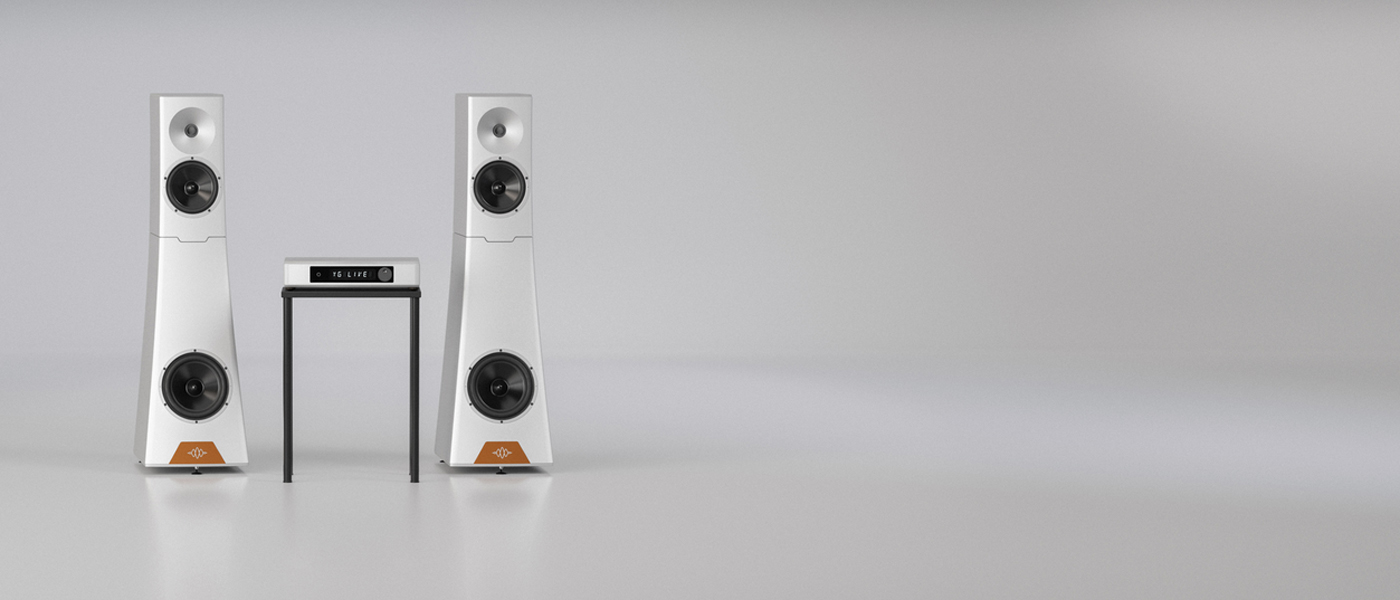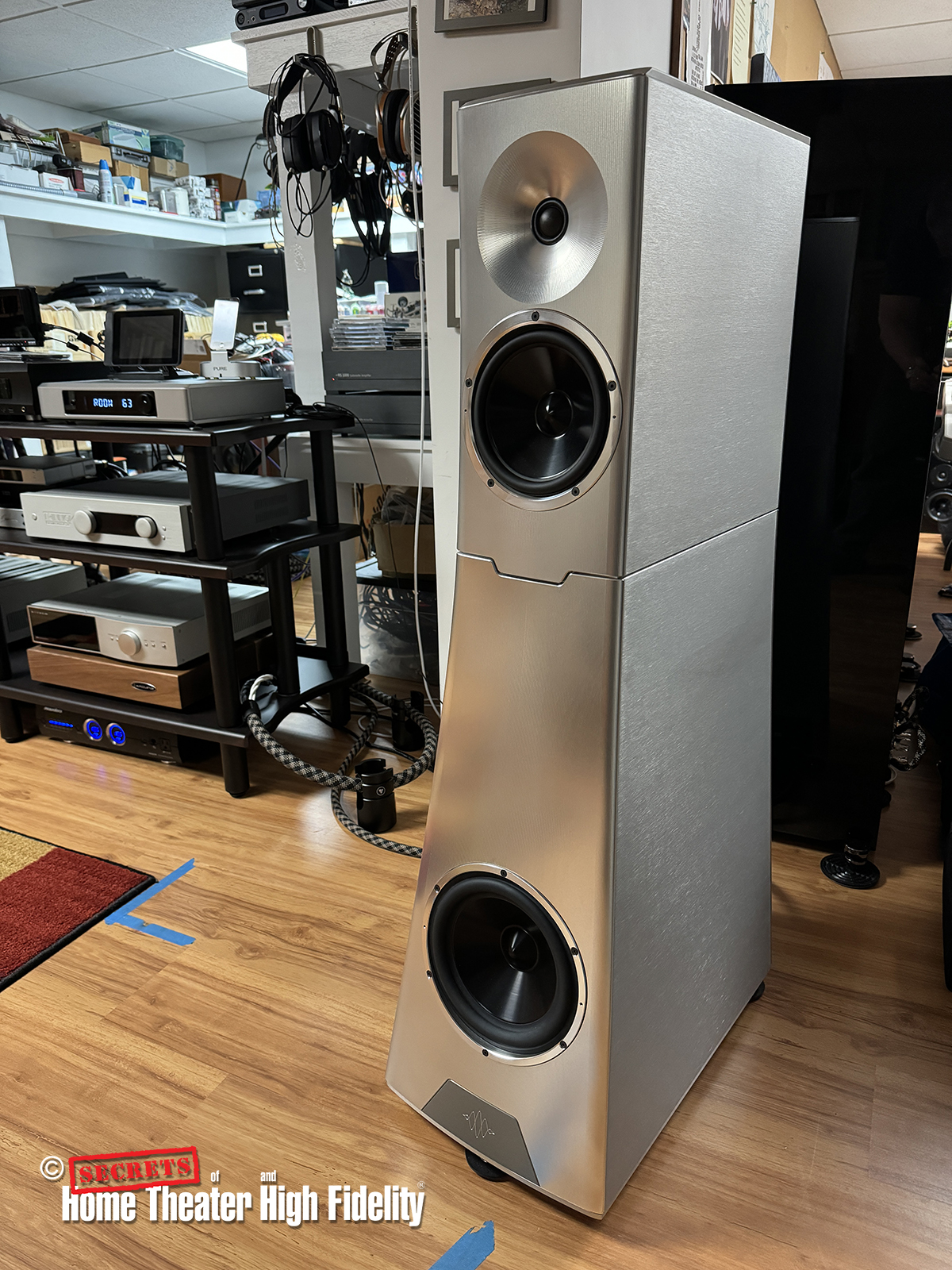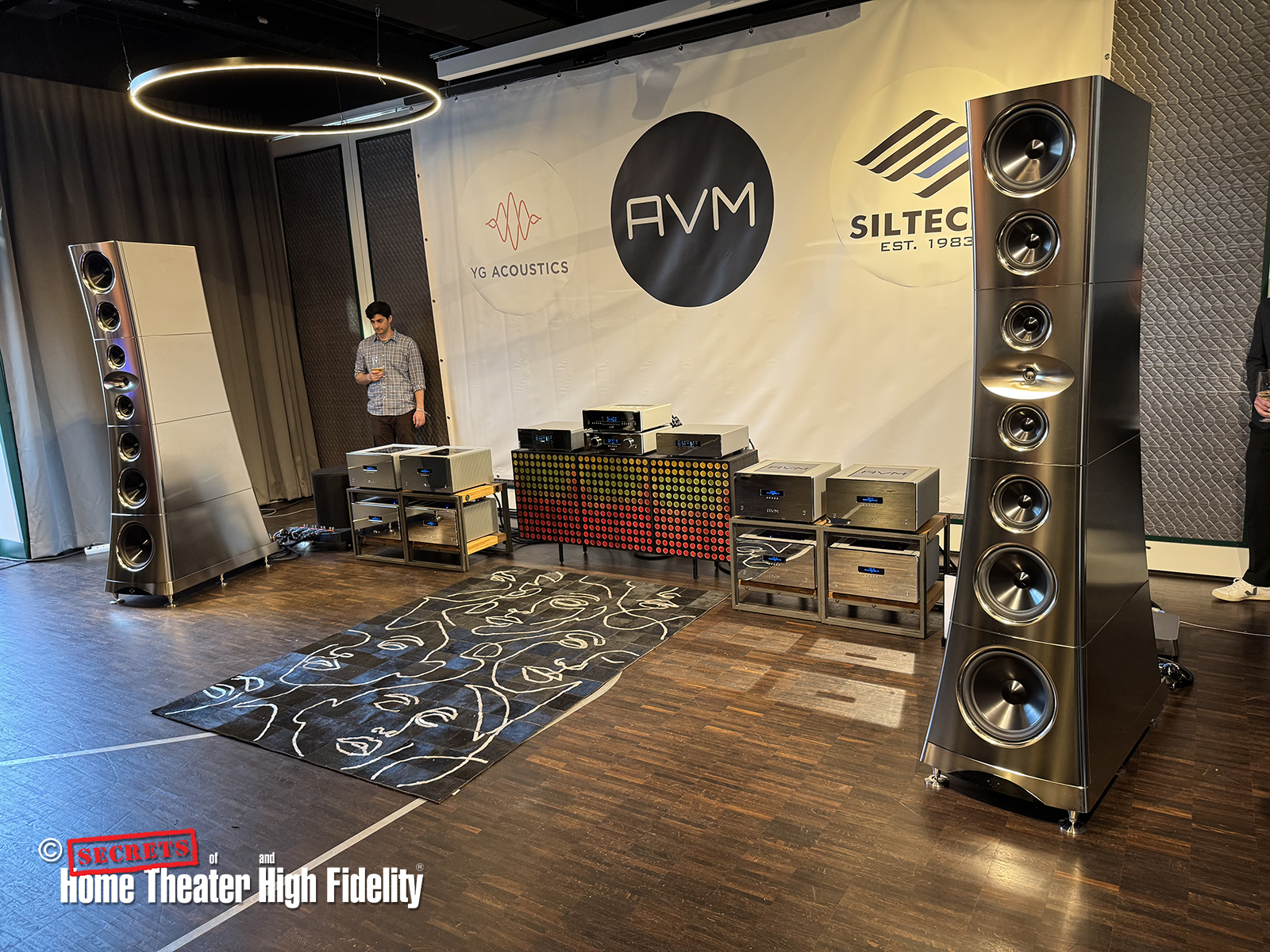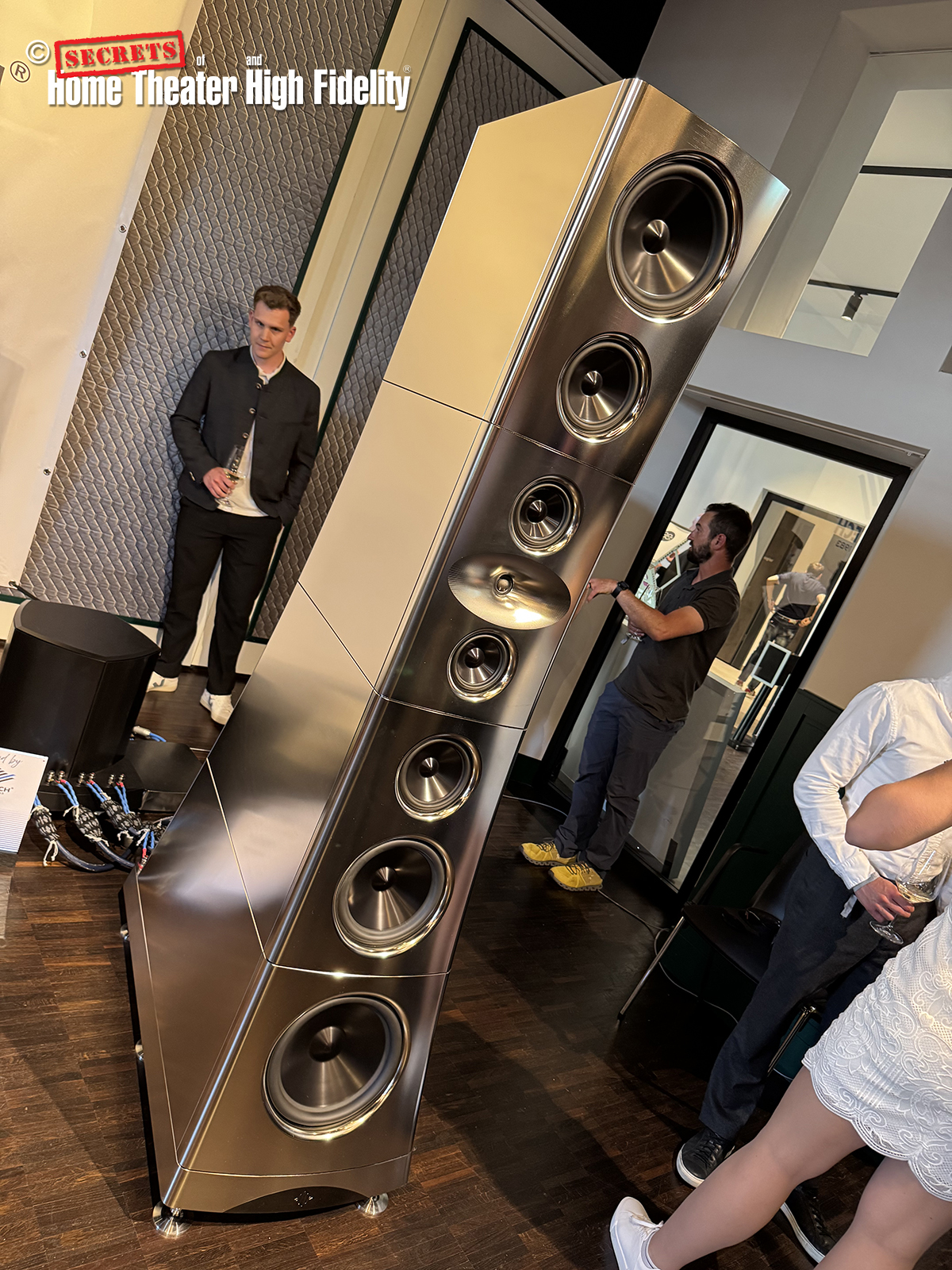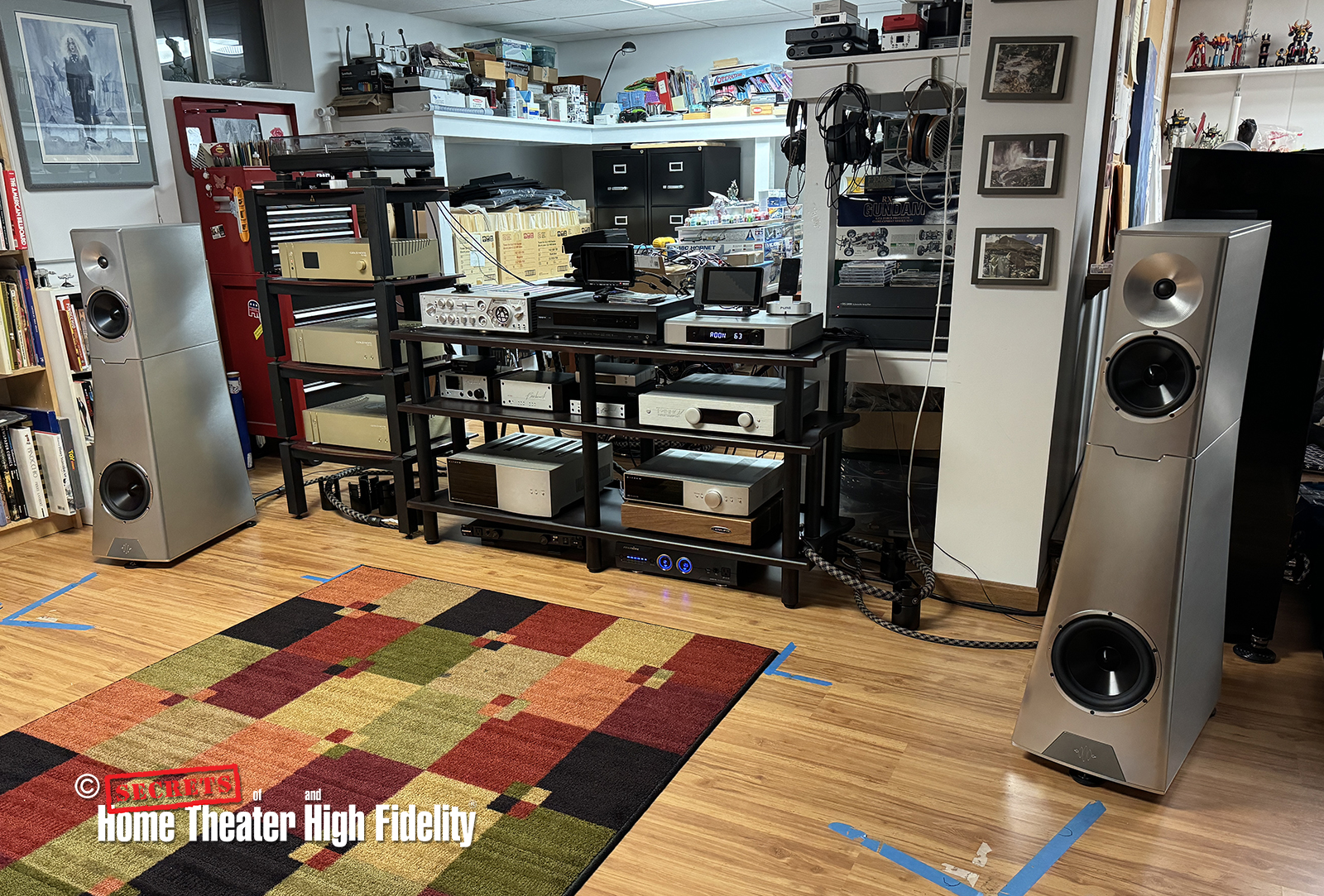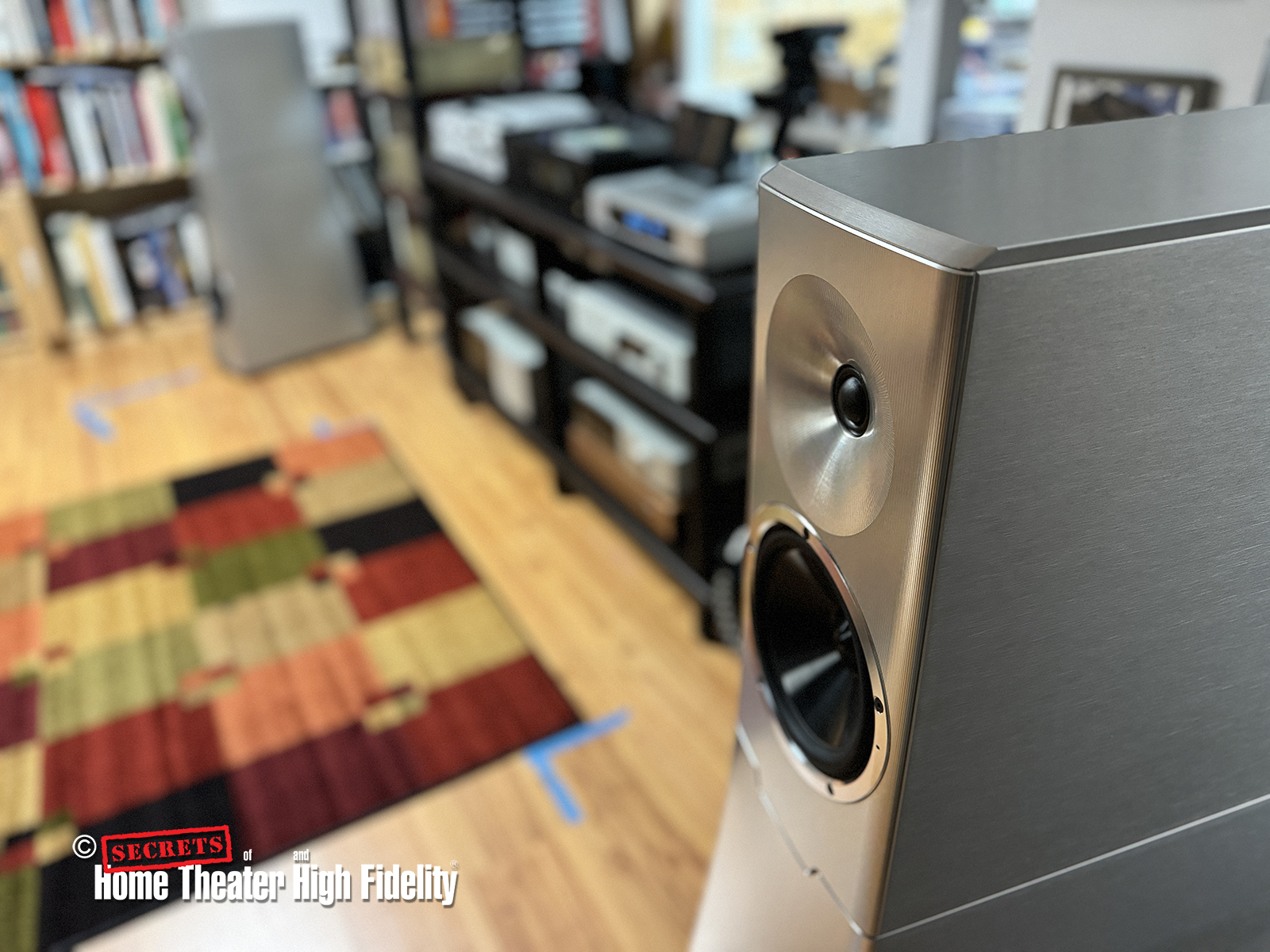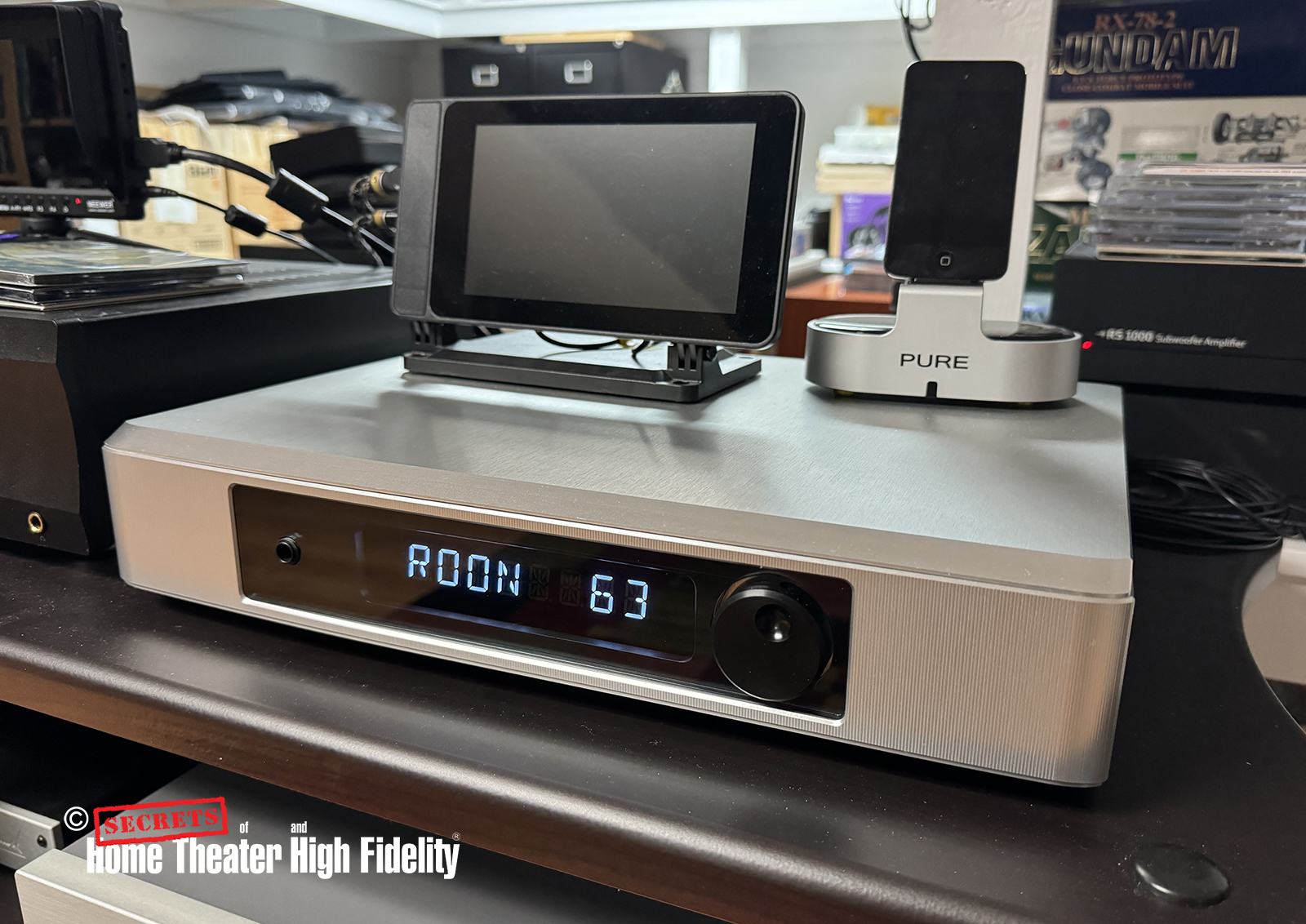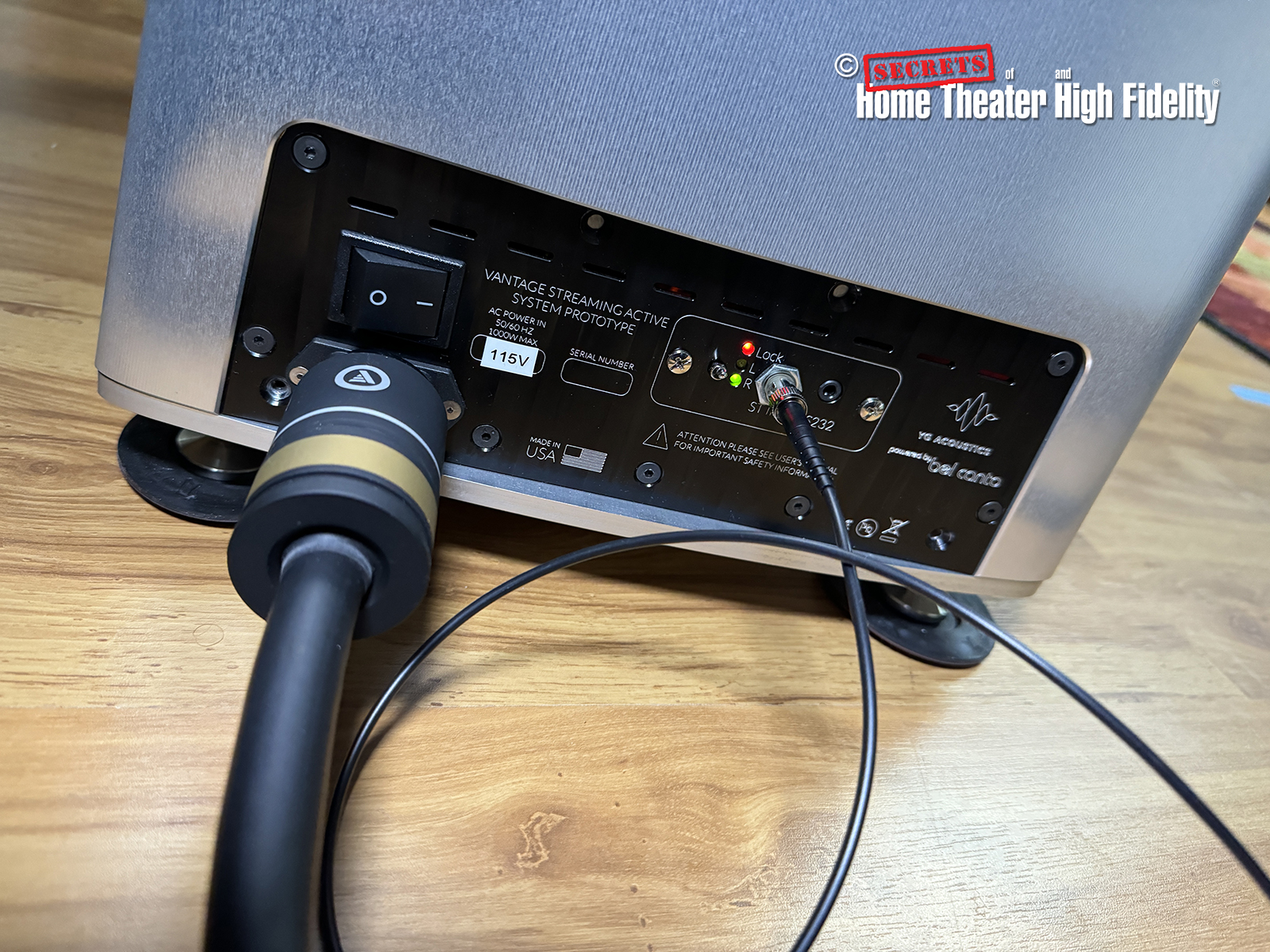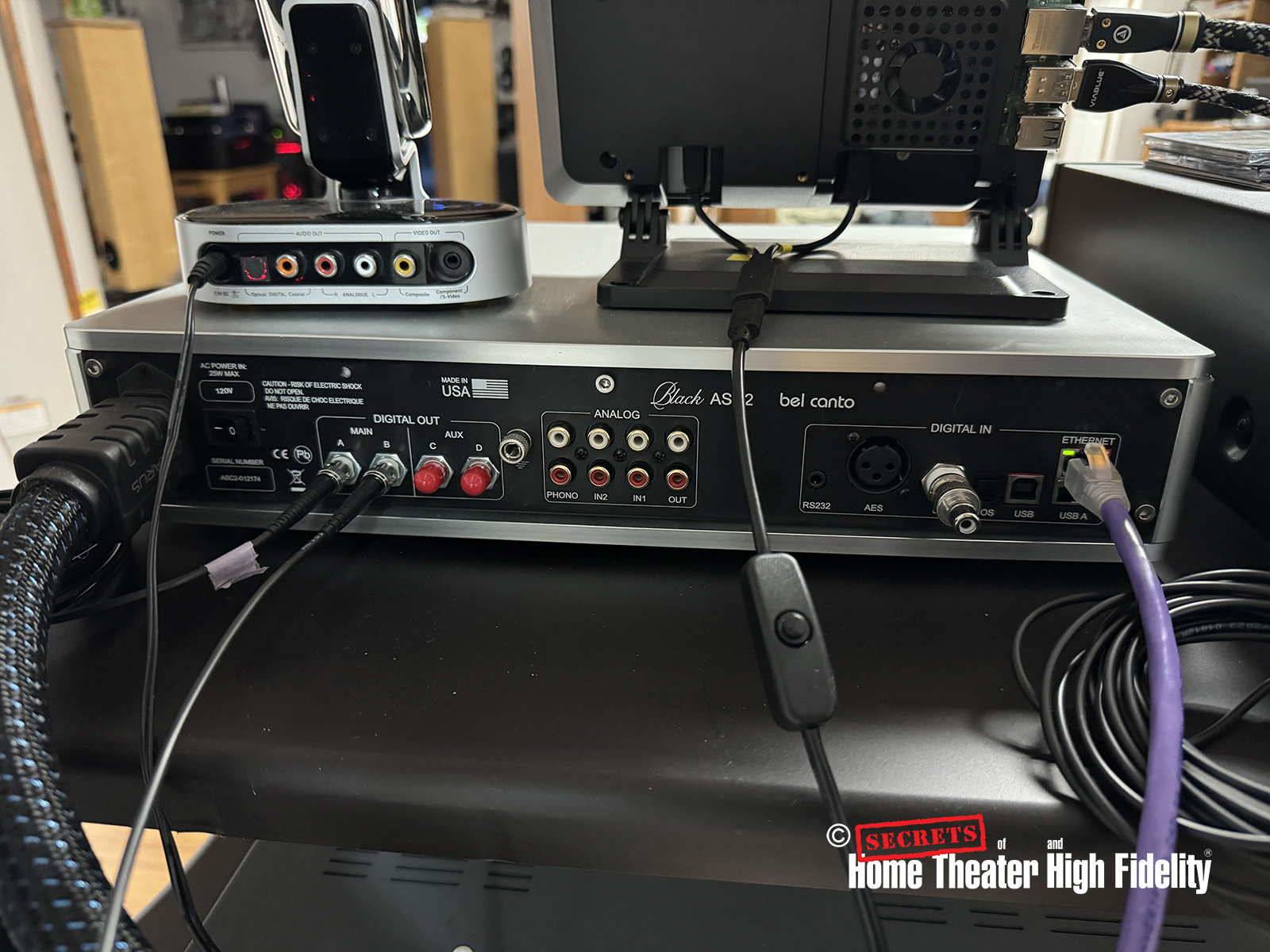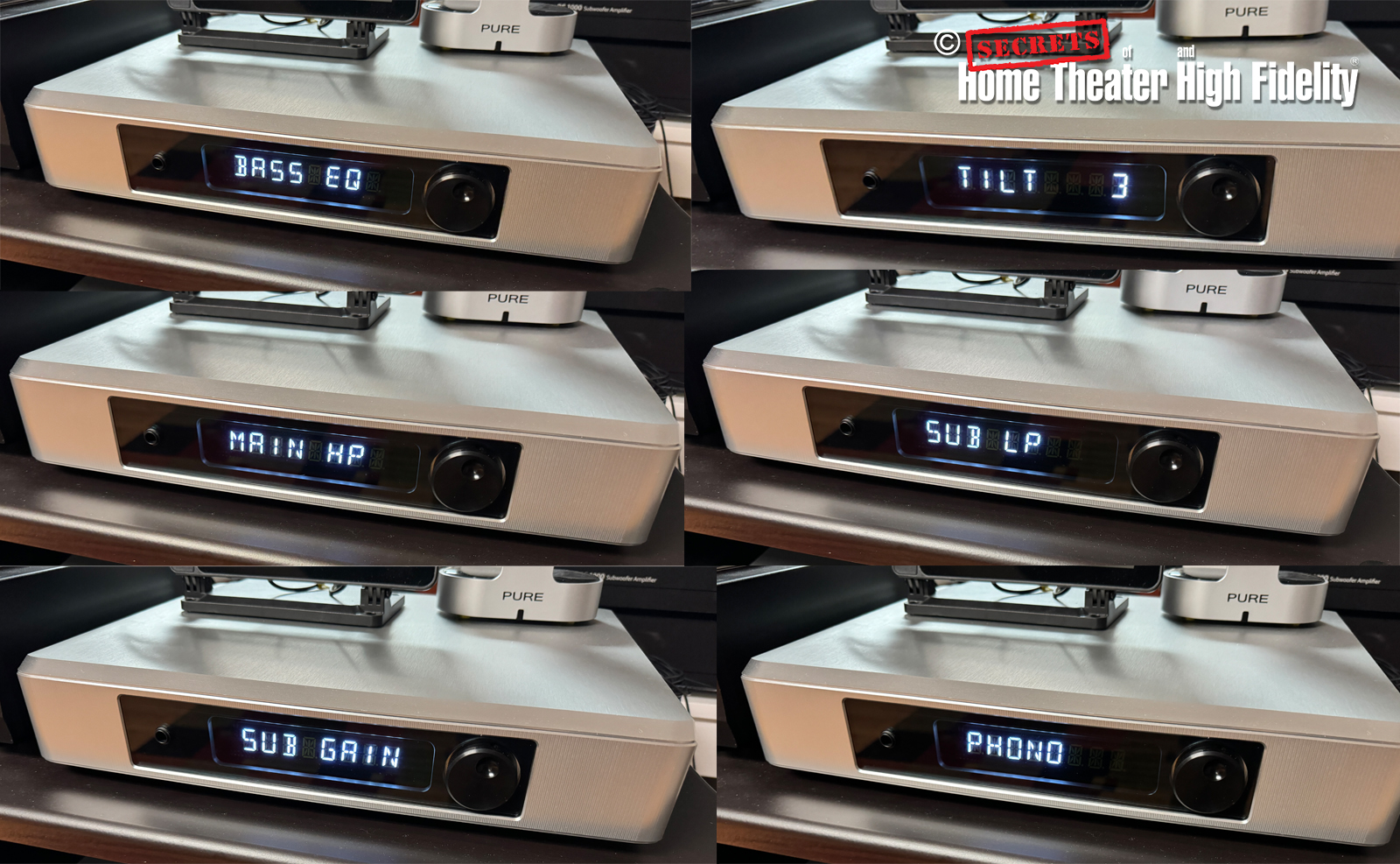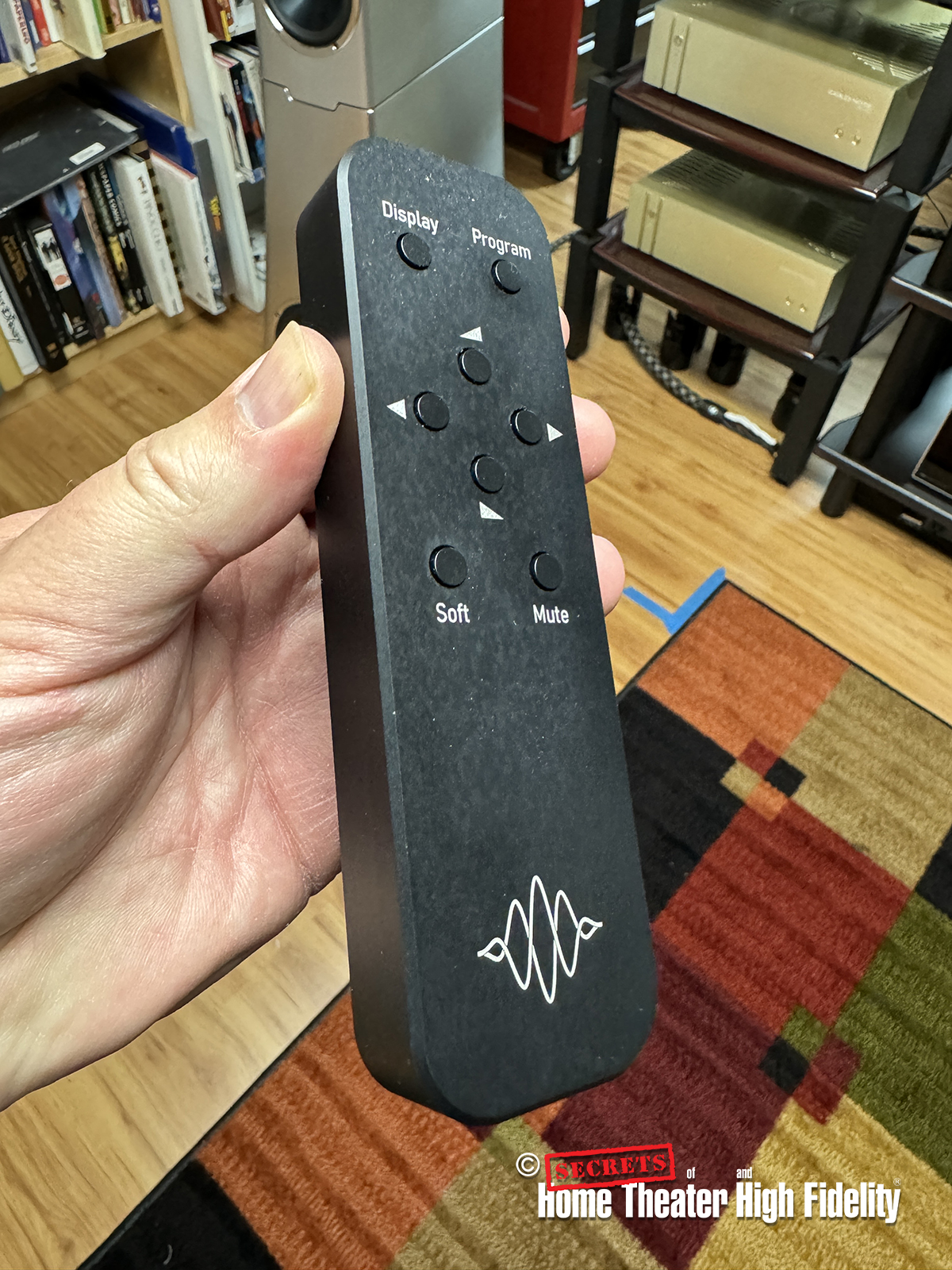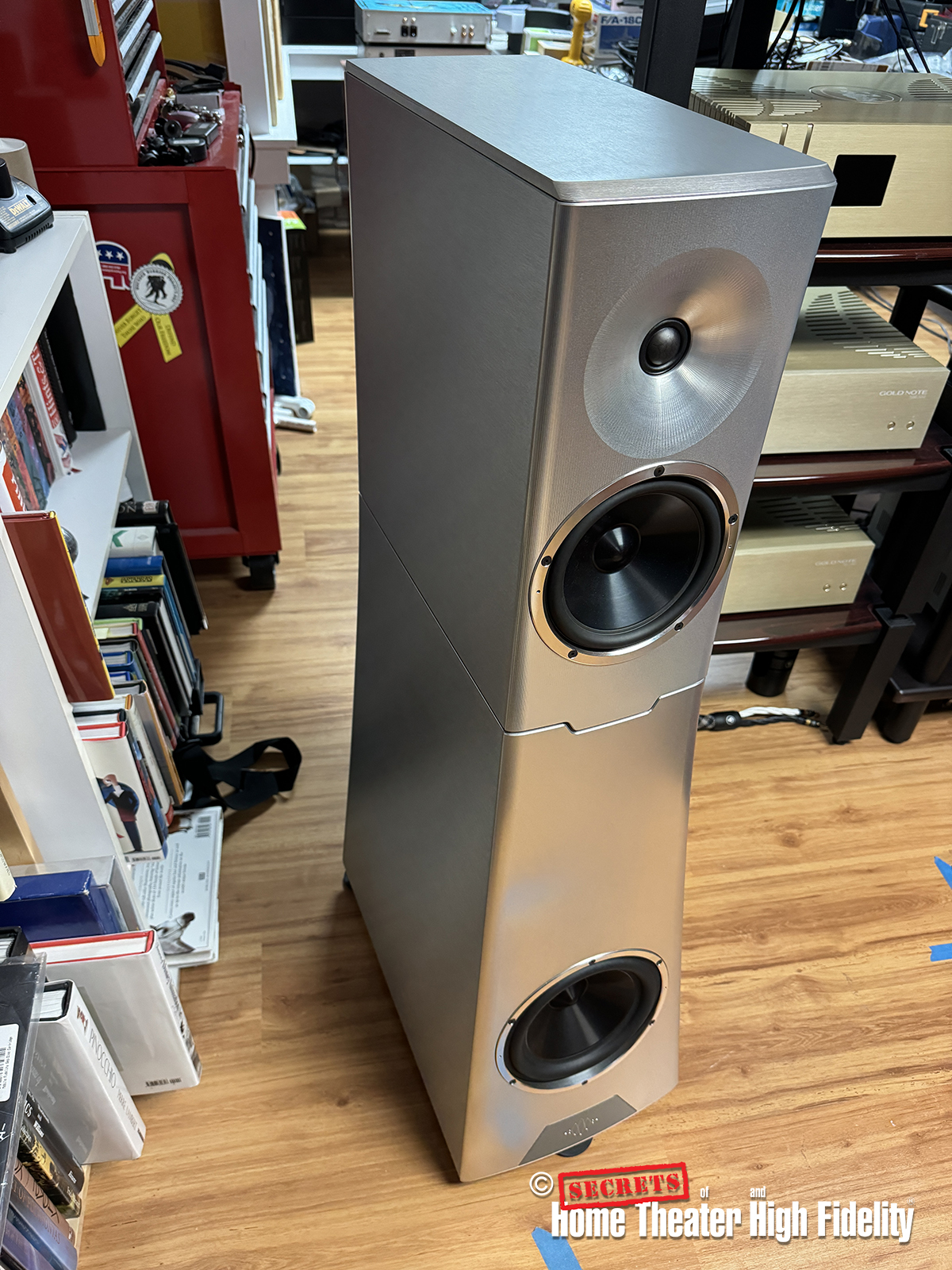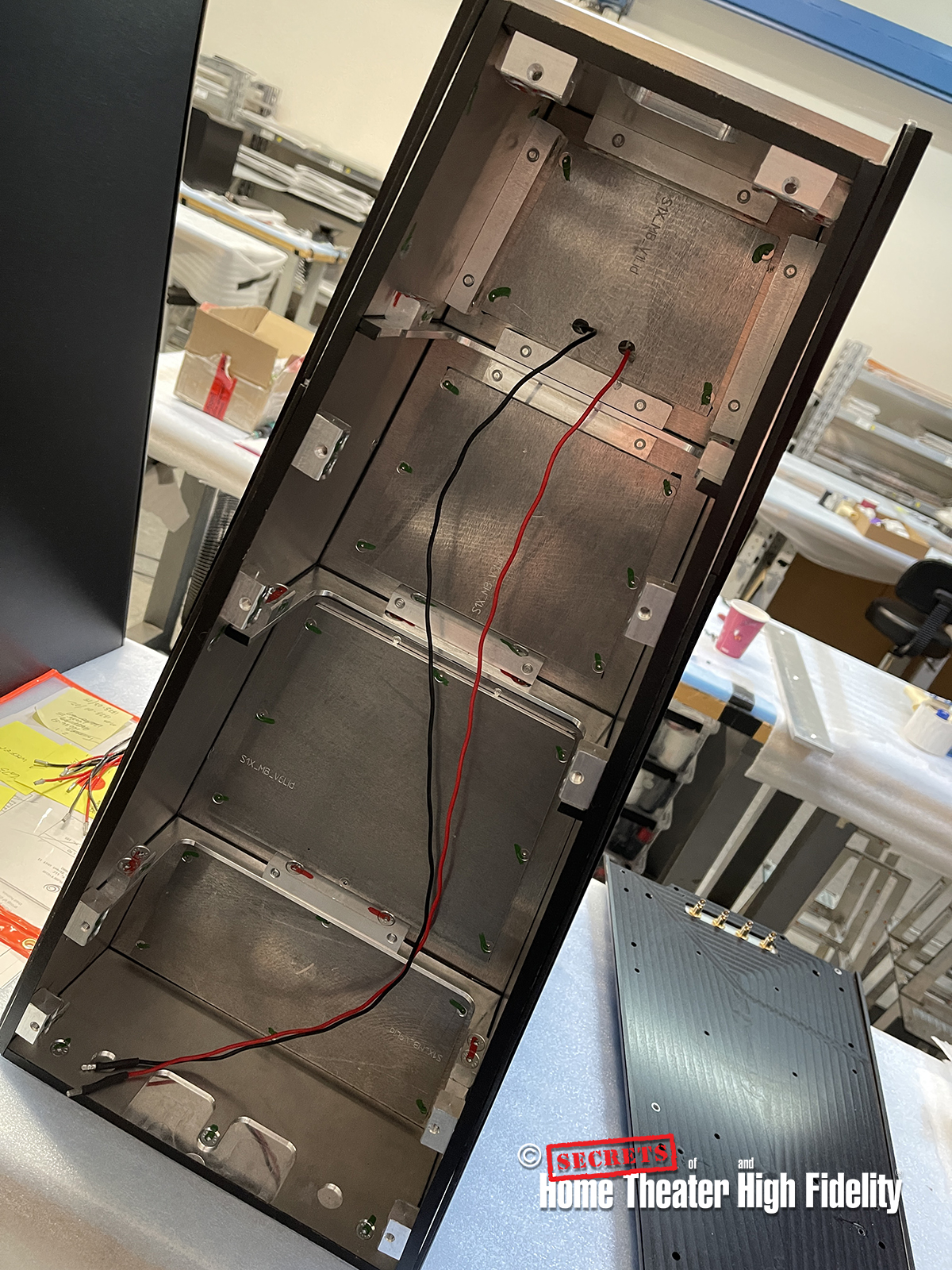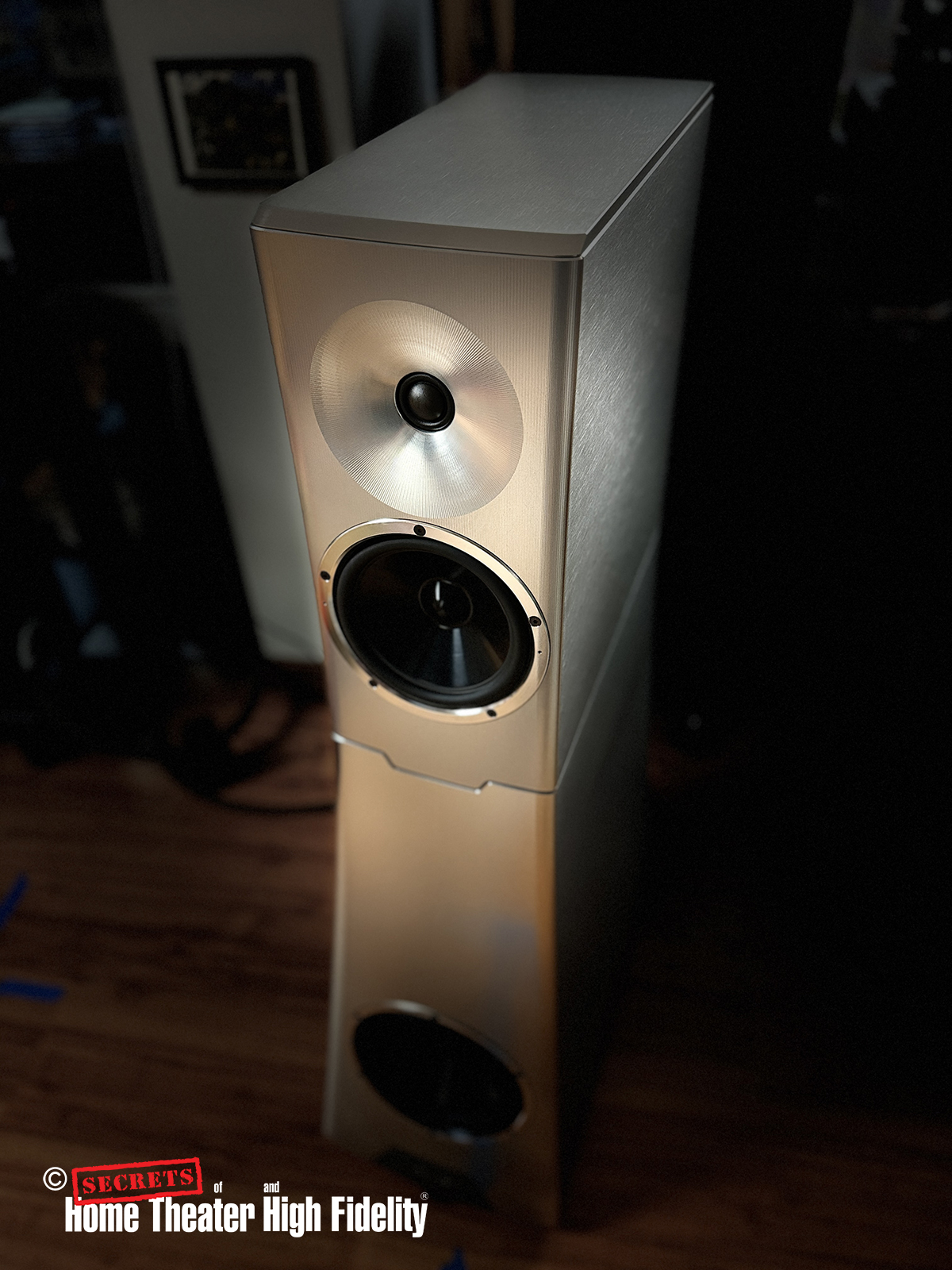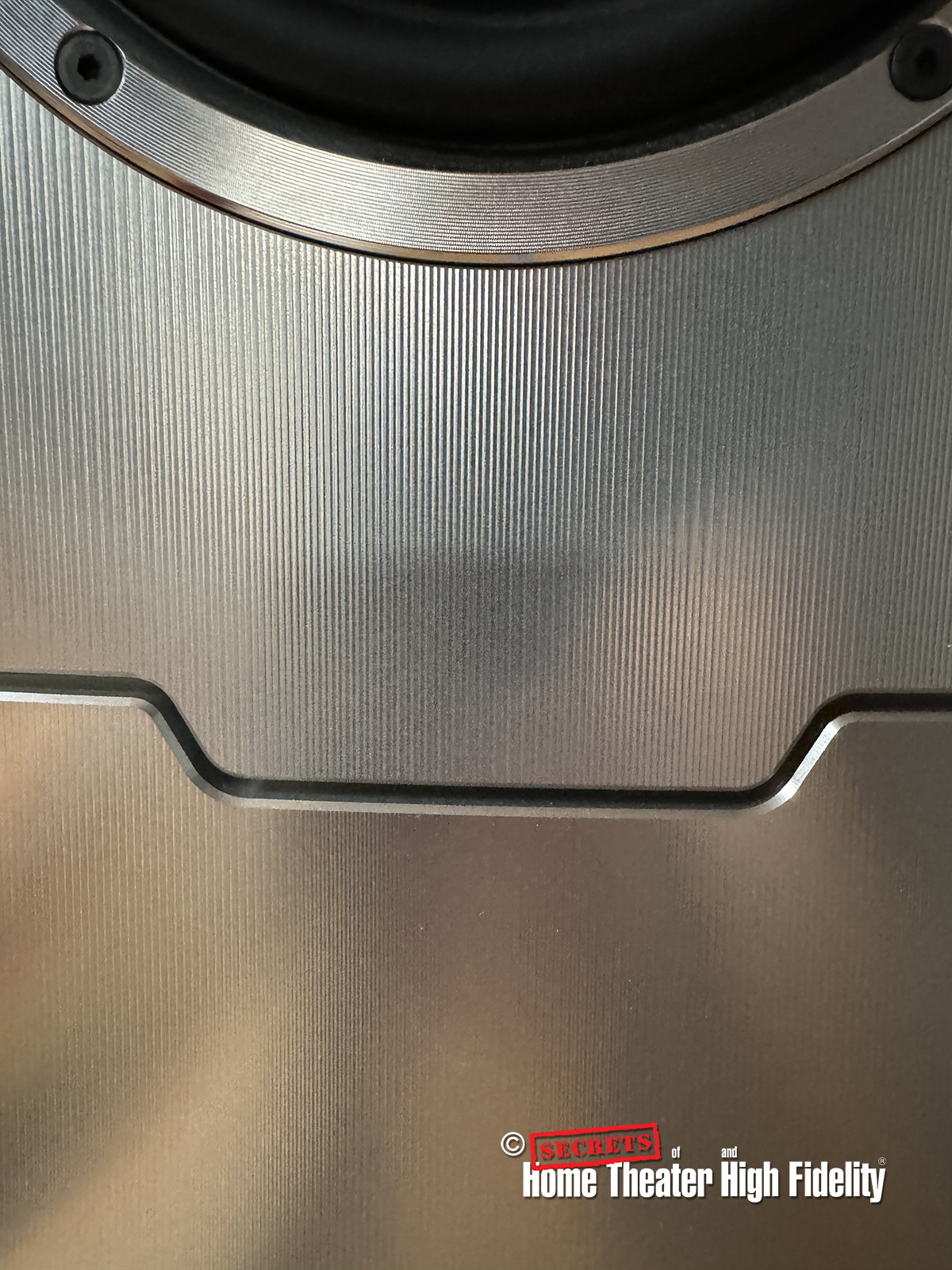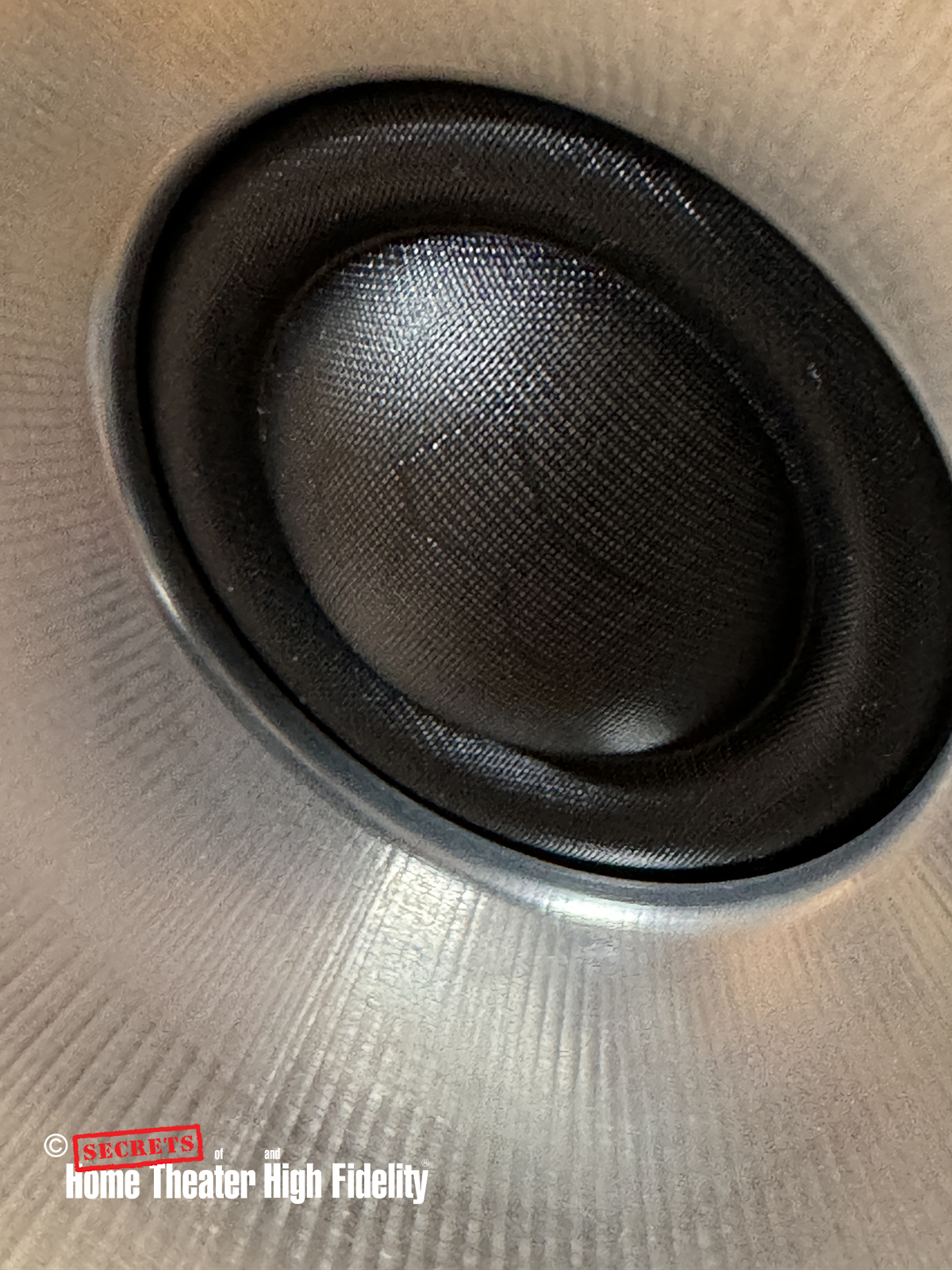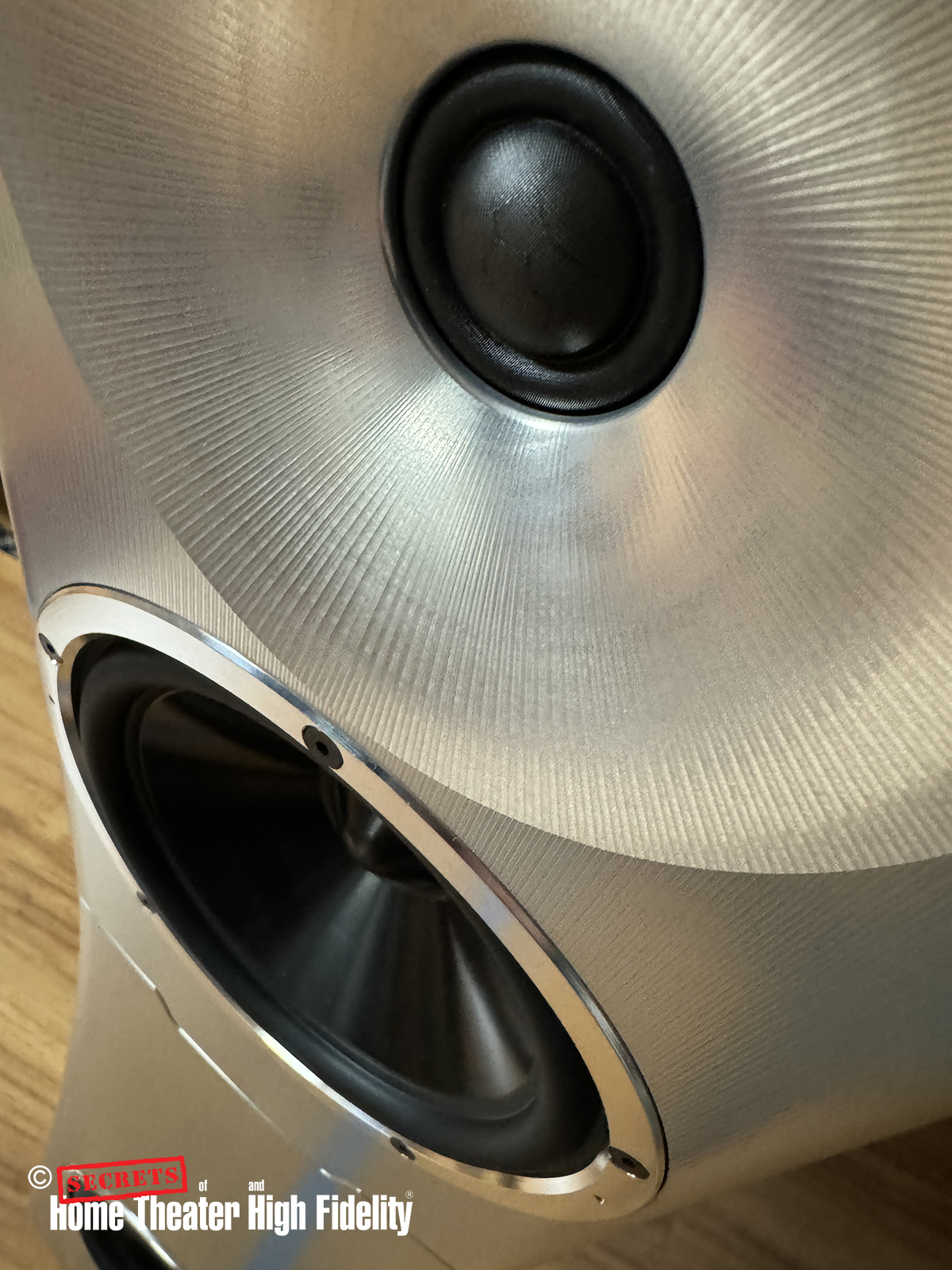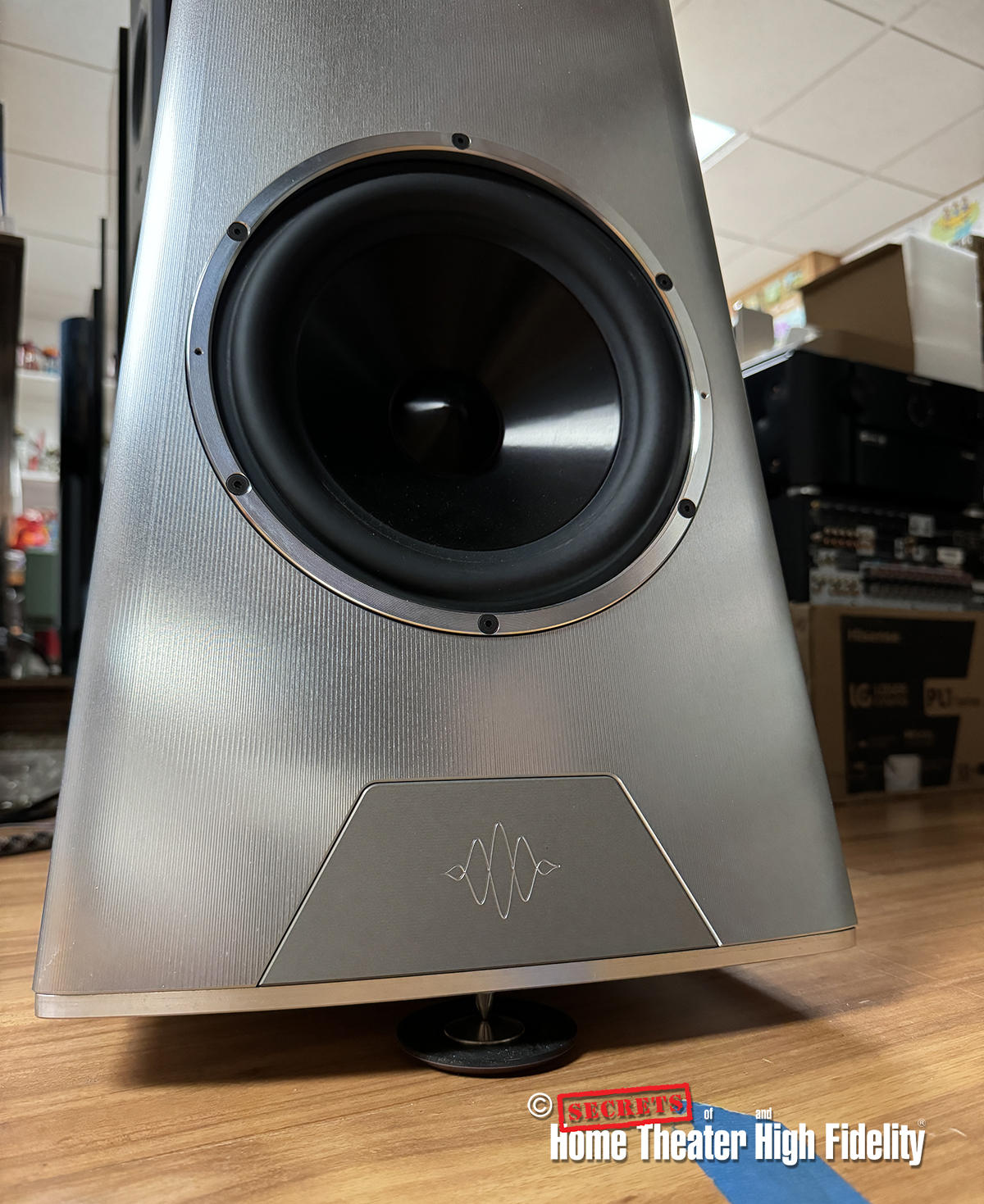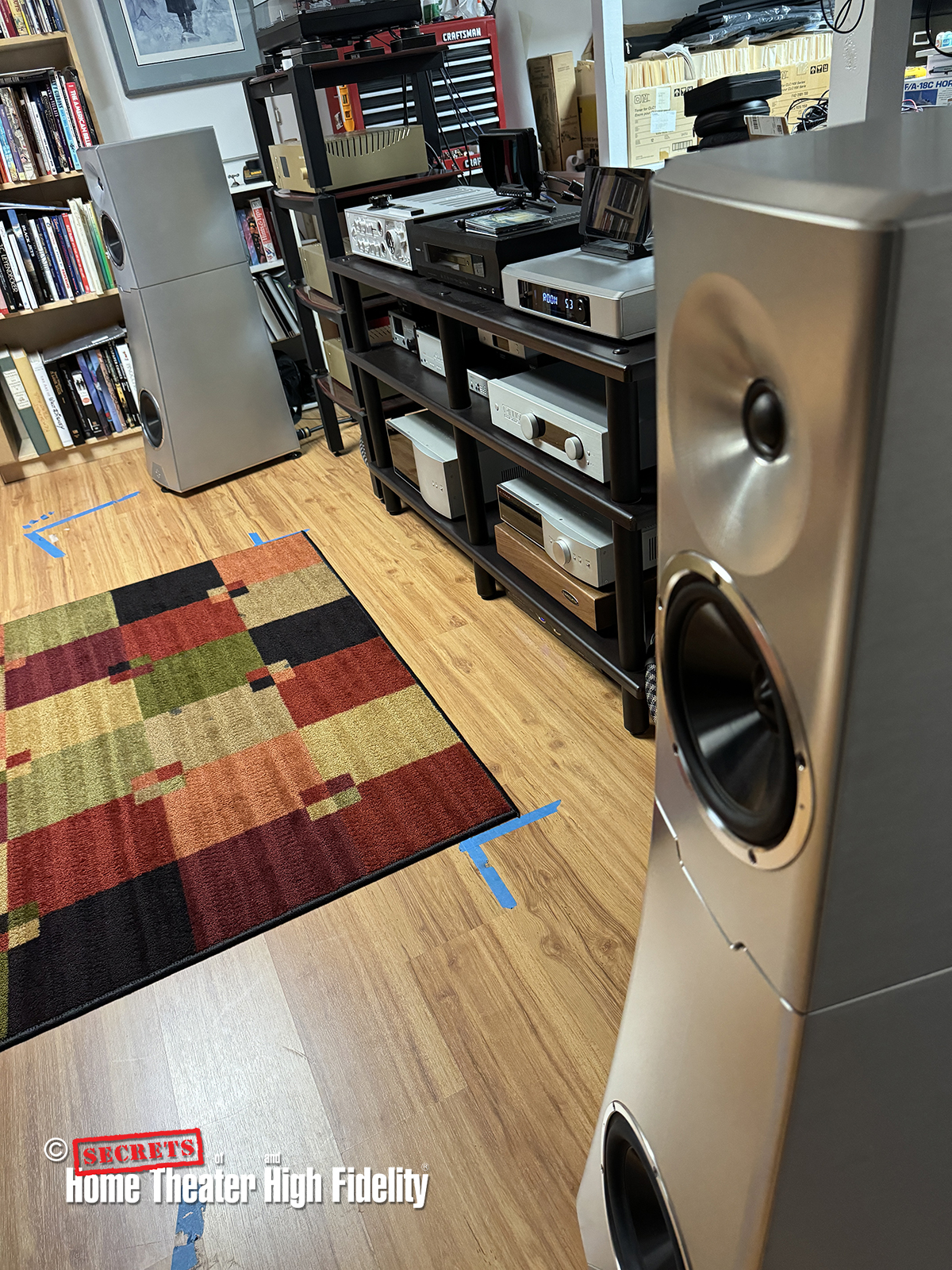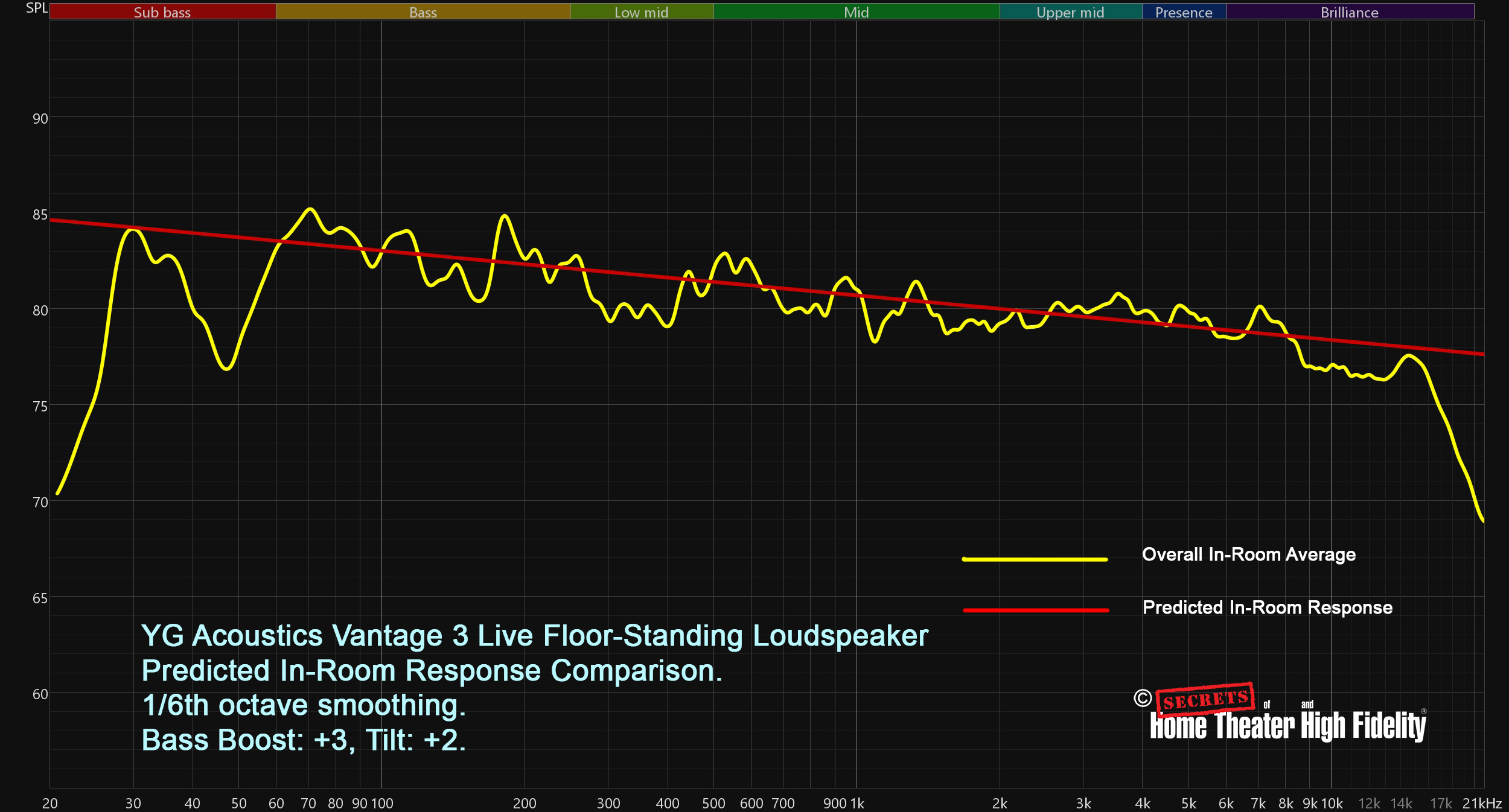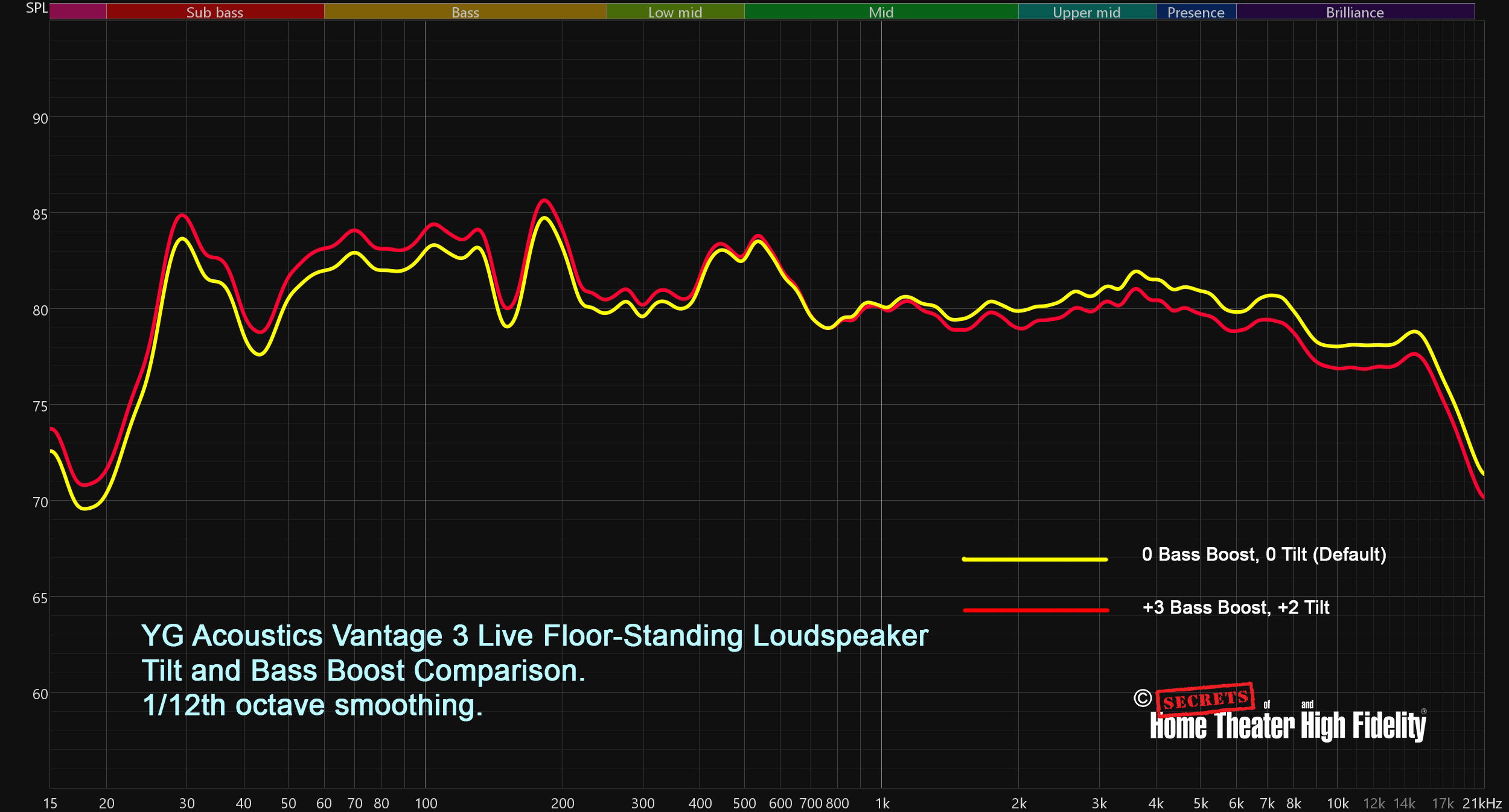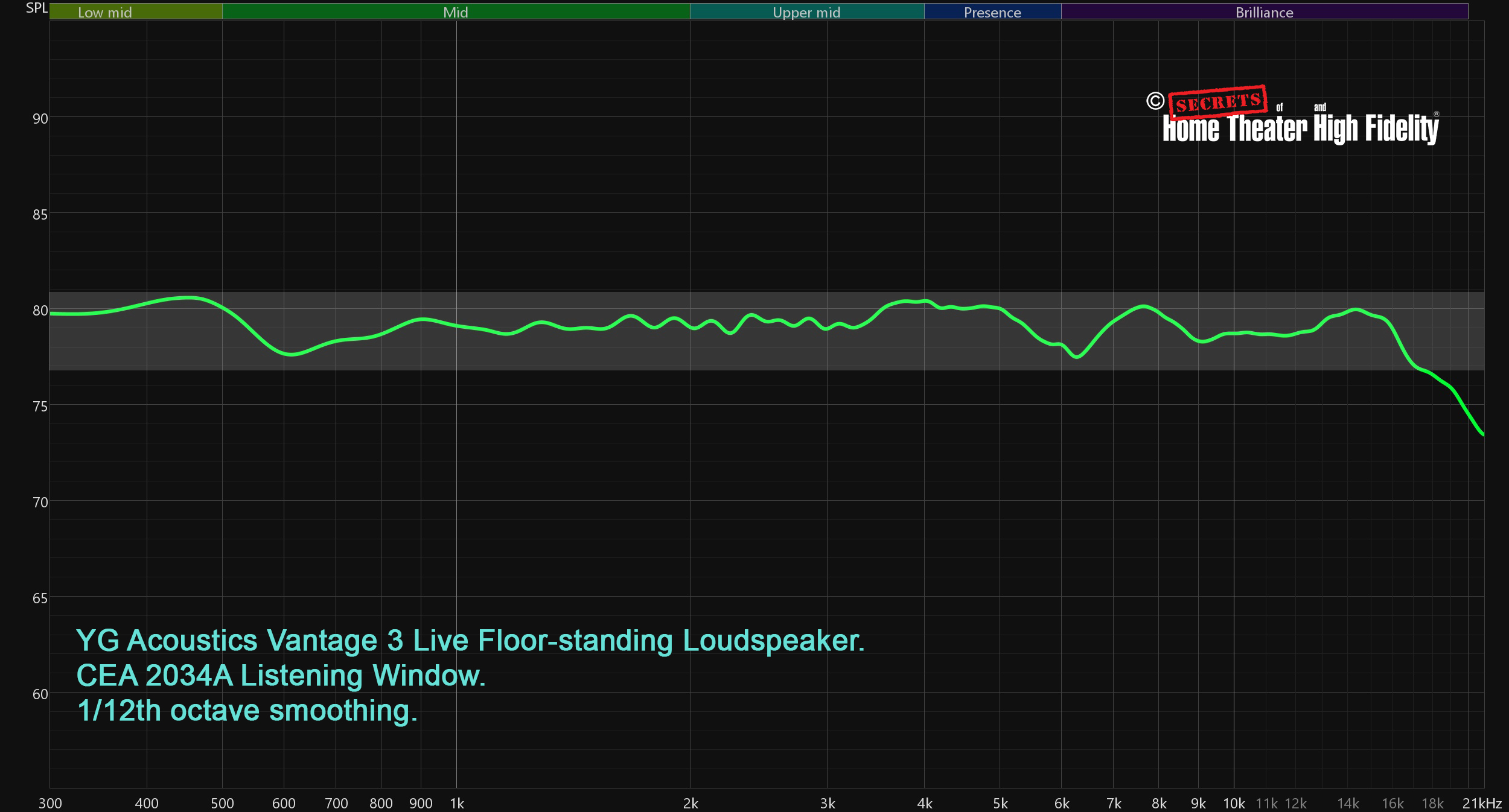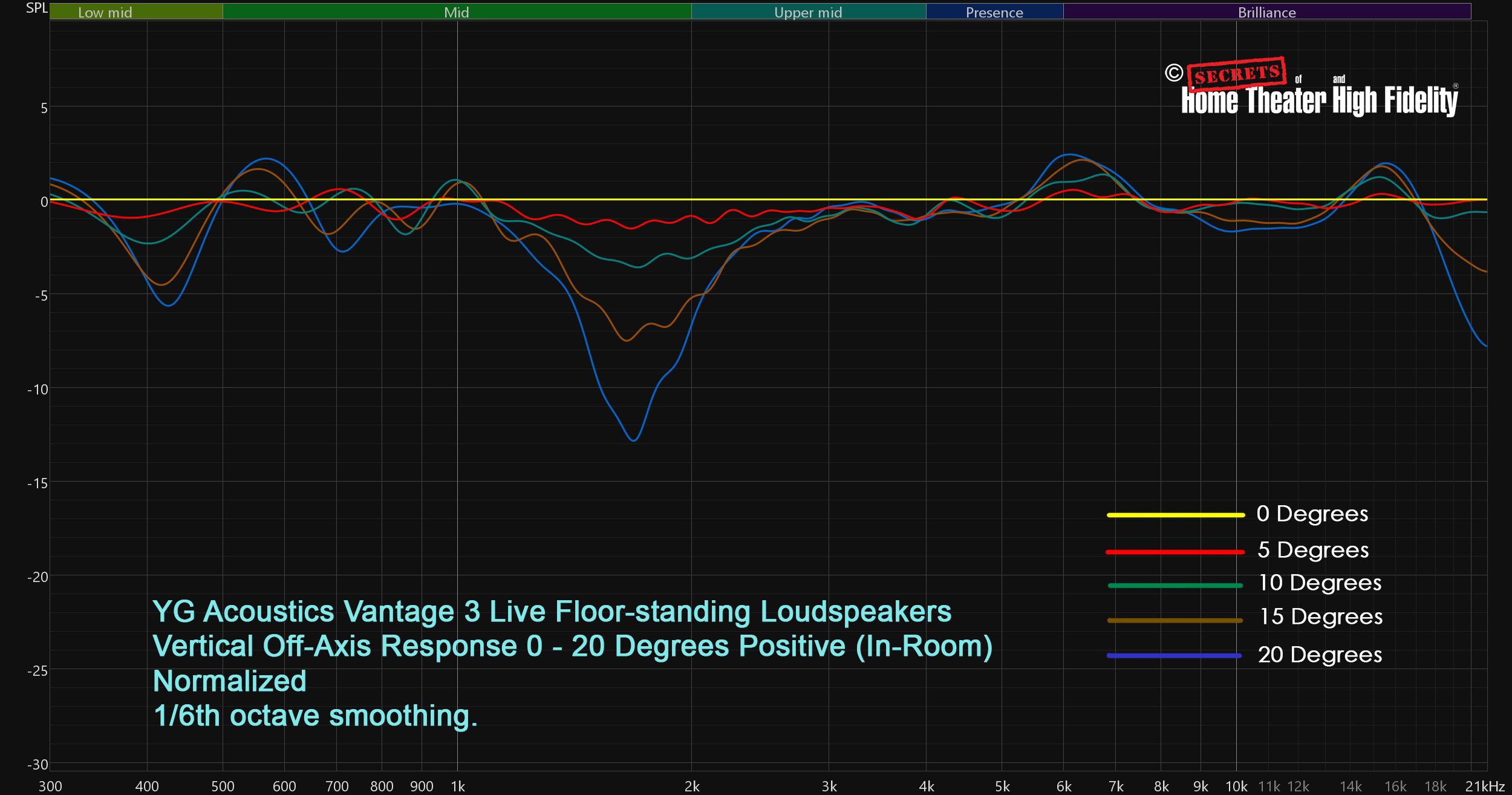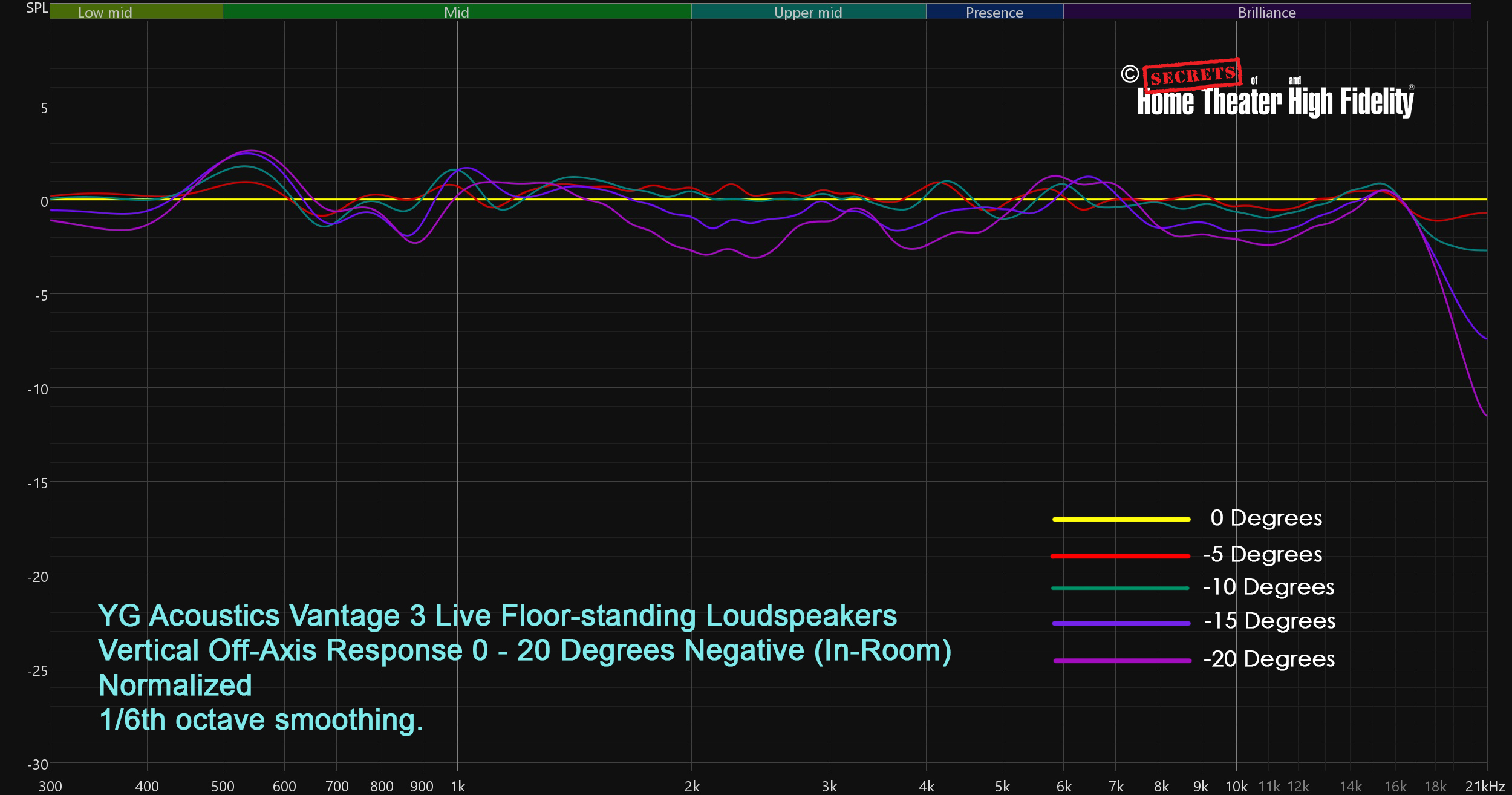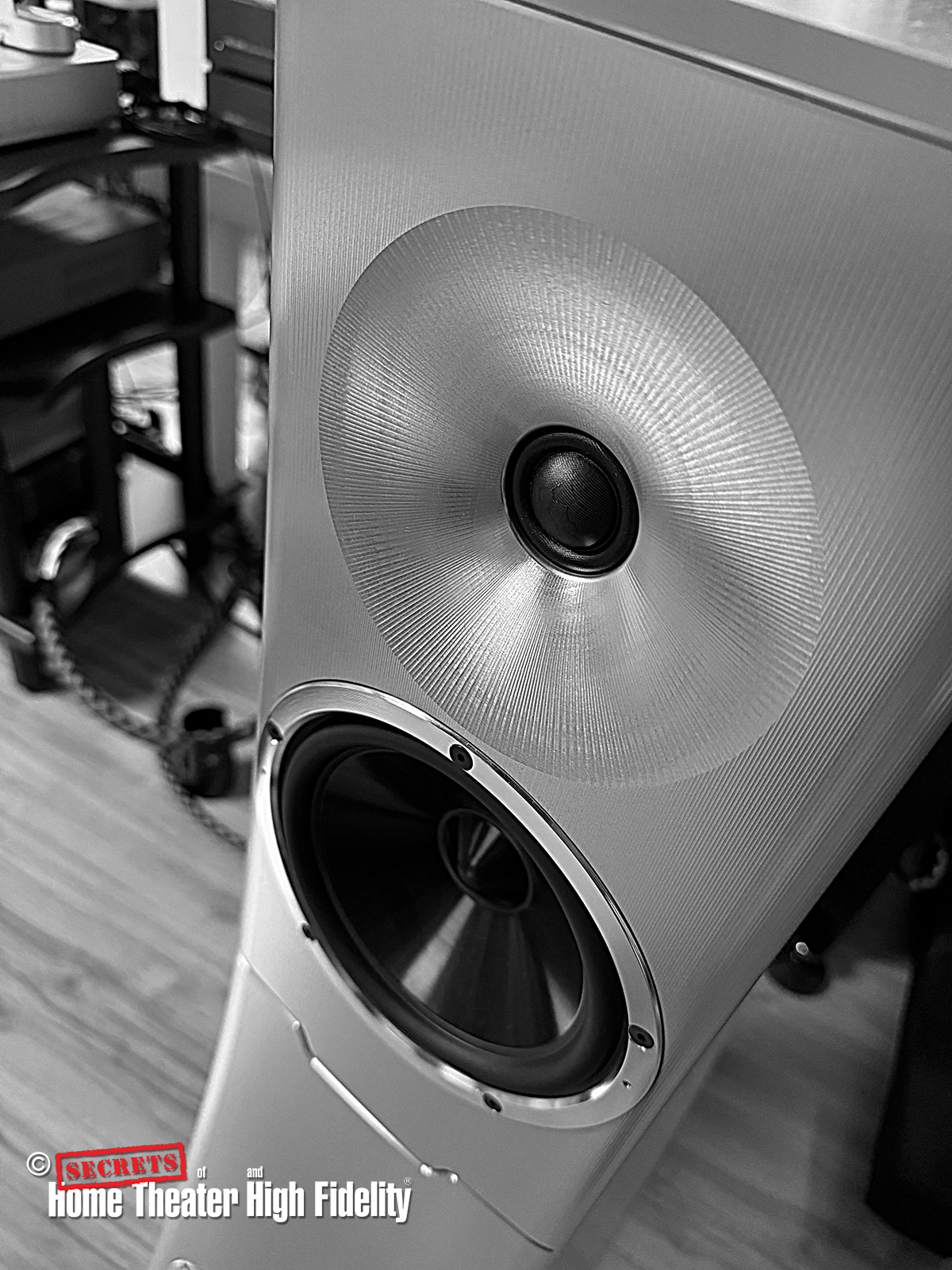You know, the kind of speaker systems that really need a room to be built around them. This isn’t that. It is something completely different and, for my money, a far more impressive and elegant solution.
It was clear from my 2023 visit to YG Acoustics that they are a company that prides itself on being at the technology forefront when it comes to loudspeakers. Looking at the details of what goes into the cabinet manufacturing and the driver and crossover design work, it’s hard not to come away impressed with what this small Colorado-based company can produce. That being said, elaborate passive loudspeakers requiring scads of amplifier power to drive them (along with the other associated electronics for control and sourcing) are easy to find in high-end audio. Before FOCAL’s recent launch of its active Diva Utopia loudspeakers, YG Acoustics had already created the comparatively downsized, very elegant, very intelligent, and very active Vantage 3 Live loudspeaker system.
YG Acoustics Vantage 3 Live Active Loudspeaker
- Simple yet deceptively powerful integrated speaker system.
- Built-in Roon Ready streaming. Works with Tidal Connect and Qobuz Connect, so it’s essentially plug and play.
- Main Control/DSP unit can accommodate a pair of subwoofers, along with bass boost and tilt controls.
- Controller has built-in MM and MC phono stage.
- Novel ST Glass fiber optic cable connection to speakers.
- Electronics and amplification are designed in partnership with Bel Canto.
- Transparent and engaging sound that can be tweaked to taste or room conditions.
YG Acoustics definitely knows how to make an impression. At this year’s Florida and AXPONA shows, they had a massive XV3 Signature speaker system, and at Munich High-End, the company wowed showgoers with a newly unveiled speaker system called the Titan.
Both systems had different electronics fronting the speakers, but the theme and effect were the same. Several large components were driving a set of large passive (albeit wildly advanced) speakers. Essentially, it was the apex of traditional “audiophile” thinking and execution. And while it all sounded great and looked impressive, it begs the question, “How much farther can we go with the development and evolution of the passive (dumb) loudspeaker?” Especially after I’ve seen with my own eyes the work that a company like YG goes through in developing every facet of its passive speakers. Realistically speaking, what more is there?
Well, not simply content to blow everyone’s doors off with the monumentally “big and badass” when it comes to loudspeakers and gear, YG Acoustics has craftily gone the other way, too. The Vantage 3 Live Active Loudspeaker system that is the subject of this review is the culmination of everything YG knows how to do with speakers, but distilled into a smart, elegant, and easy-to-live-with turnkey solution. It gives one all the sonic benefits (and bragging rights) of a high-end “audiophile” system without all the headaches and hassle. To borrow a metaphor from the personal computer world, an Apple Mac level of closed eco-system and style, but with a Microsoft Windows level of sonic tweak-ability.
Design:
3-way acoustic suspension DSP active loudspeaker with preamp controller supporting analog, digital, phono, and Roon Ready streaming inputs.
High Frequency Driver:
Single 1-inch soft dome tweeter with integrated aluminum lattice.
Midrange Driver:
Single 7.25-inch BilletCore driver with advanced neodymium motor magnets.
Bass Driver:
Single 8.75-inch BilletCore driver with ultra-high field strength motor.
Frequency Response (Manufacturer):
26 Hz – 40 kHz
Built-in Amplification:
Class-D, 700 watts per driver. Total of 2100 watts per speaker.
DSP Controller:
Integrated preamp/DAC/streamer with digital and analog inputs and outputs.
Streaming Resources:
Roon Ready, Tidal Connect, Qobuz Connect, Spotify Connect
Digital Inputs:
AES-XLR (1), SPIDF-BNC (1), Toslink (1), USB-PC (1), USB-A (1), Ethernet.
Digital Outputs:
Two Main BNC Optical, Two Aux BNC Optical.
Analog Inputs:
RCA analog (2), MM/MC Phono RCA (1).
Analog Outputs:
RCA analog subwoofer L and R.
Controller Dimensions:
94 × 400 × 316 mm (3.7 × 15.7 × 12.4”) H×W×D
Controller weight:
8.7kg (19.2 lbs.)
Speaker dimensions:
112 × 32 × 54 cm (44 × 13 × 21”) H×W×D
Speaker weight:
80 kg (176 lbs.) each unpackaged
Standard Finishes:
Silver and Black, optional finishes available.
MSRP:
$71,000.00 for the system.
Website:
Company:
SECRETS Tags:
yg acoustics, active, dsp, loudspeaker, audiophile
Secrets Sponsor
It goes without saying that a properly designed active loudspeaker, through eliminating the passive crossover components, incorporating precisely tuned DSP, and directly coupling and matching the ideal amplification to each drive unit, will outperform a purely passive speaker of similar caliber. That’s not hyperbole or speculation, it’s physics.
The Vantage 3 Live is indeed a proper set of active 3-way loudspeakers. YG Acoustics partnered with a fellow respected audio brand, Bel Canto Designs, for the electronics and amplification to create an unconventional but effective synergistic solution. The entire system begins with the central controller unit, where Bel Canto drew inspiration from its BLACK system of audio components. It is a fully digital system that uses high- powered DSP to provide the user with a significant level of flexibility. It converts all incoming analog signals to digital via a high-quality A/D converter, and all signals are clocked and outputted digitally via custom fiber optic cables to each speaker, where the D/A conversion and amplification take place.
Using Angel-hair-pasta-thin fiber optic cable instead of python-thick suspended windings of copper and silver to connect the speakers? Sacrilege!
Still, being active, each speaker needs to be plugged into a power outlet, so if you feel the need to compensate, you can dust off your super-special audiophile power cables and put them to work!
The controller has a full suite of digital inputs, including optical, AES (XLR), BNC (these three have an input bandwidth of up to 24-bit 192 kHz), PC-USB (up to 24-bit 384 kHz and DSD128 over DOP), and Ethernet (up to 24-bit 192 kHz and DSD64). The system is fully Roon Ready through the Ethernet input, and it will also work with Tidal Connect, Qobuz Connect, and Spotify Connect, so if you don’t have a Roon subscription, that’s not a problem. As the controller is designed by Bel Canto, it will work with the company’s Bel Canto Seek app (iOS only), which allows a Vantage 3 Live owner to stream from Qobuz, Tidal, Spotify, and vTuner internet radio, along with accessing music files from Dropbox, OneDrive, or a NAS. There are two sets of analog inputs in addition to an MM and MC phono input with adjustable impedance loading for MM cartridges. There is a set of RCA analog outputs (full range) that can be used for stereo subwoofer outputs.
The handy thing about the controller keeping everything in the digital domain is that it can offer useful features such as a granular bass boost/cut, a handy frequency tilt feature (the tilt axis is at 775 Hz), subwoofer low pass/mains high pass settings, and overall subwoofer gain control.
The front of the controller has a very simple and straightforward digital display reminiscent of an old digital clock radio. It shows the one-word input/setting state and a numerical level value. The single rotary knob to the right controls level and mode selection and allows pressing to select. There is also a 1⁄4” headphone jack to the left of the display.
YG provides a simple, minimalist remote that, in true YG Acoustics fashion, is milled out of a billet of aluminum and has a nice bit of heft to it. Just don’t drop it on your foot or a glass table!
Turning to the speakers themselves, the enclosures are, as YG Acoustics is known for, made from milled aluminum panels. The cabinet is divided into two sections. The “monitor” section is its own sealed enclosure housing the tweeter and midrange drivers. This is bolted to the sealed bass stand section. While the larger active YG speakers (the XX Live and Sonja Live) have double-layer aluminum wall construction with a constrained damping layer, the Vantage 3 Live uses a single, thicker-layer aluminum wall construction. All the internal bracing used is also made from milled aluminum billet.
YG Acoustics likes to use aluminum for its speaker cabinets because of aluminum’s high stiffness-versus-weight ratio, and because it can be precisely machined into almost any shape the company desires. YG claims to have mitigated any issues with cabinet resonances or ringing through an intelligent bracing and damping strategy. These details are confirmed by firsthand observations during my 2023 visit to YG Acoustics and touring the manufacturing area.
Aesthetically, I like the looks of these speakers. The shape of the cabinets is fundamentally traditional when it comes to speaker design, but there are plenty of subtle curves, bevels, and other detail touches that elevate the overall aesthetic. Note the perfectly aligned milling marks on the front baffle that flow into the waveguide and converge at the tweeter.
Observe the exactness and uniformity of every panel seam, especially that beveled separation line between the monitor and bass sections. It all adds up to create a deceptively simple but visually cohesive and attractive whole. Add to this the impressive build quality and the physical solidity of these speakers, and you can feel the care and attention to detail that has been paid to the Vantage 3 Live. $71K per pair is a lofty sum, but you start to get a tangible sense of what you’re paying for here.
On the driver side of things, the Vantage 3 Live starts with a custom 1-inch soft dome tweeter that has an integrated, impossibly fine, aluminum lattice mesh. This mesh is custom milled in-house by YG. The company calls this tweeter a “Hybrid Lattice Dome” design, which they claim harnesses the best sonic qualities of soft dome tweeters with the strength of metal dome tweeters together in one. The tweeter also has the benefit of being mated to an integrated waveguide that is milled directly into the aluminum front baffle.
The midrange driver is a 7.25-inch custom aluminum coned unit called BilletCore. The ultralight 0.2 mm thick cone is precisely milled from a full billet round of aluminum by YG, it’s anodized, and then installed in the driver. The same process is used to create the 8.25-inch BilletCore woofer cones as well. YG claims the use of high field strength motors with neodymium magnets in these drivers.
As noted earlier, a digital signal is carried to each speaker via a single BNC glass fiber optical cable, after which the signal is converted to analog by DACs within each speaker and then amplified by the on-board Class-D amplifiers. Each speaker has a separate 700-watt amplifier dedicated to each drive unit, for a total of 2,100 watts of amplification per speaker.
The Vantage 3 Live is available in either Silver or Black anodized standard finishes, but the company has the custom capability to finely anodize any color or hue that a customer might desire on their new speakers for an additional cost.
The YG Acoustics Vantage 3 Live were positioned in my large studio listening space about 9.5 feet apart, with the listening position approximately 11 feet away from the center point between the speakers. After some experimentation, I settled on the speakers being toed-in such that a direct line from each tweeter would converge about a foot past my head at the listening position. Subjectively, this provided me with the best overall imaging and detail.
The associated equipment used for stereo evaluation, which was a lot less than normal with this kind of system, consisted of:
– OPPO BDP-105D Universal Disc Player.
– GeerFab D.BOB Digital Breakout Box.
– Technics SL1200 Mk6 Turntable modified by KAB Electroacoustics.
– Audio-Technica ART20 MC Phono Cartridge.
– Viablue power cables.
Listening to the Vantage 3 Live in my room for the first few days, with the controller using its default settings, I found the sound to be very well balanced and revealing. Its standard tuning wasn’t quite studio monitor flat and linear like the RBH PM-8 Active monitors that I reviewed a few years ago. The Vantage 3 Live’s upper-end energy was certainly more relaxed than the RBH, and for that matter, the Bowers & Wilkins 803 D4. After those first days, though, I wanted to experiment with the controller settings to see if I could eke out just a little more bass and a slightly softer upper end without upsetting the very nice midrange balance that the speakers were giving me. As a touchstone, I am used to the sound of my Revel F228Be loudspeakers, and while I wasn’t looking to match them exactly, I did want to see if these YG speakers had the flexibility to get me closer to that general target. After a few hours of tweaking and listening to the adjustments I made in the “Bass Boost” and “Tilt” settings, I settled on a Bass Boost setting of +3 and a Tilt setting of +2 (which tilts up the bass and down the treble). This effectively gave me the most appealing tonal balance for my taste, without changing the overall character of the speaker.
Having sorted those details out, I began to focus on some critical listening with several familiar musical selections. A properly designed set of active loudspeakers has a sense of transparency and immediacy that even the best passive speakers cannot hope to match, and the YG Acoustics Vantage 3 Live were bearing that out, in spades! The Vantage 3 Live had everything one would hope for from a high-end set of loudspeakers. A very wide soundstage that extended well beyond the speakers themselves, an excellent sense of depth to the image they threw, but added to that, an ability to resolve an uncanny level of acoustic detail.
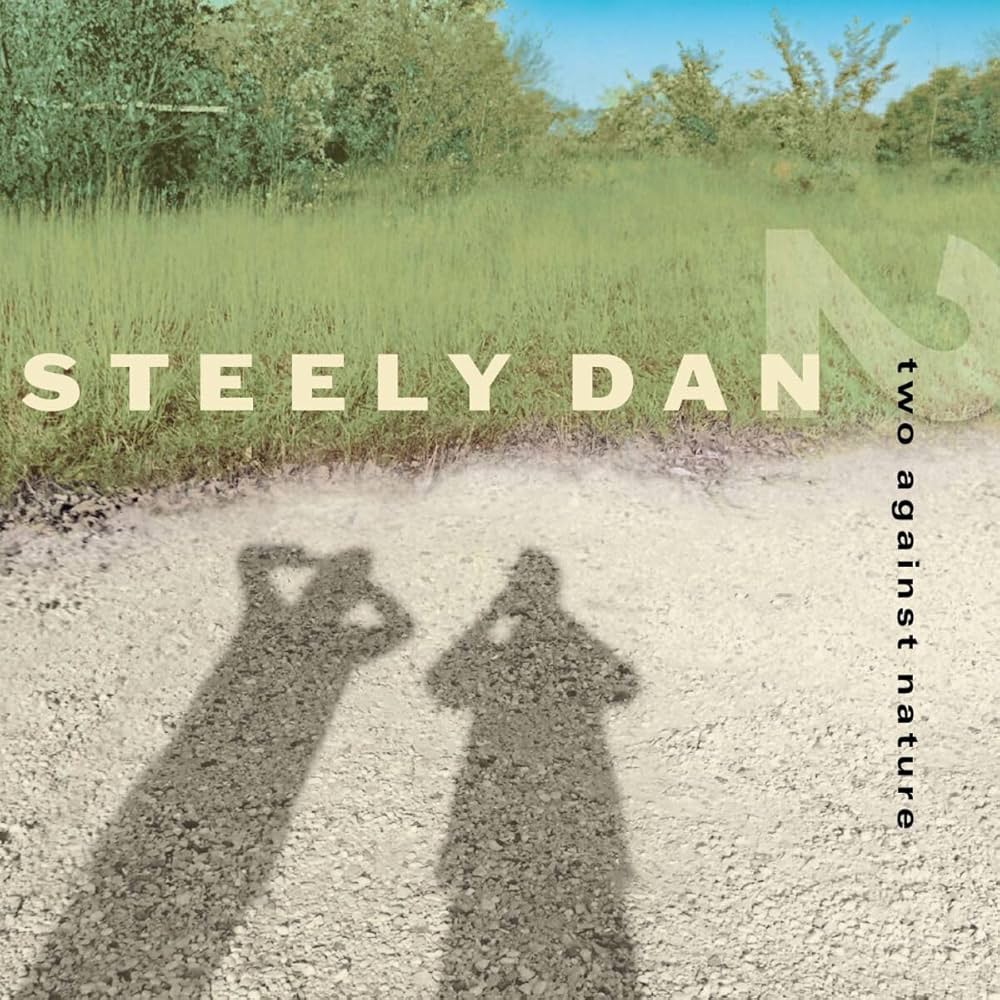
Steely Dan, Cousin Dupree, “Two Against Nature”, 24-bit 96 kHz stream from Qobuz.
This is probably the first recording I play with any new set of speakers I get in for review. It is beautifully recorded and has such a broad range of musical elements that it allows me to quickly sort out if there are any tonal issues across the speaker’s bandwidth.
Plus, it’s a great track with skilled musicianship, wry lyrics, and a hell of a groove to it, so I never tire of listening to it! The Vantage 3 Live presented this track with a pleasingly wide and deep image. The opening basslines hit with solidity, and the following synthesizer fills sounded full, with a nice sense of dimension. While the bass and synths underpin the whole track and give it its foundation and size, the Vantage 3 Live doesn’t allow the other instruments and percussive details to get overwhelmed by them. Drum hits were tight and crisp-sounding sounding with the cymbals having an appealing sizzle as they trailed off. Donald Fagen’s voice was perfectly centered in the mix and had his trademark nasally quality without coming across as overly thin. Walter Becker’s tasteful guitar work had both a clean ring and bite to each note that came through clearly. I was paying attention for any lean-sounding areas or noticeable peaks or holes in the song, and I couldn’t zero in on anything objectionable. Turn up the volume a bit, and the Vantage 3 Live remained composed, clean, and clear with an exceptional sense of dynamics. These speakers are not what I would call warm sounding by any stretch, but I do find them appealing for their impression of accuracy while still remaining enjoyable to listen to.
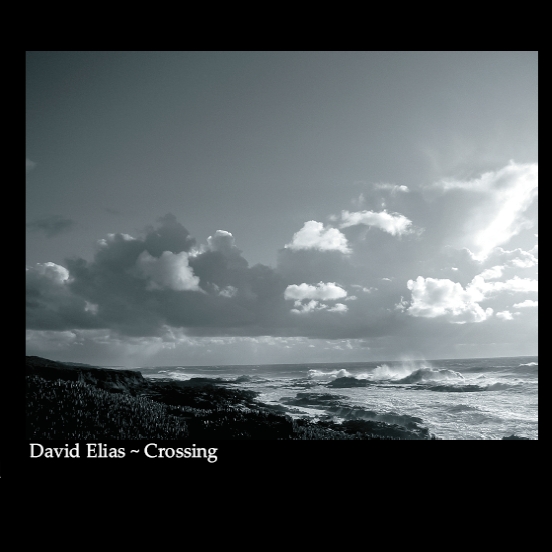
David Elias, Red Tail Guide, “Crossing”, DSD64 file streamed via ROON over Ethernet.
I’m not a big fan of “audiophile” Folk music, but this track does have a soothing moodiness to it that I like; the recording quality is very good, and the mandolin playing in it can cause havoc with insufficiently damped midrange drivers. There have been a few times where some speakers I’ve had here have elicited some unnatural ringing or buzzing as soon as the mandolin kicks in. I thought maybe the aluminum BilletCore cones might be susceptible to such unwanted excitement. Thankfully, no such issues presented themselves, and the mandolin parts were reproduced cleanly and with appealing tone. The song has some nice acoustic bass work to contrast the mandolin, and the low-mounted 8.75-inch BilletCore bass driver made me feel those plucks without the sound getting woolly or out of control. David Elias’ vocals are close-mic’d and soft spoken, but every detail from his singing is fully resolved by these speakers. While the overall track has an ease and smoothness to its presentation, the Vantage 3 Live serves the music up with an air of legit precision, versus some artificial sense of detail that is baked into some other speaker’s crossover design.
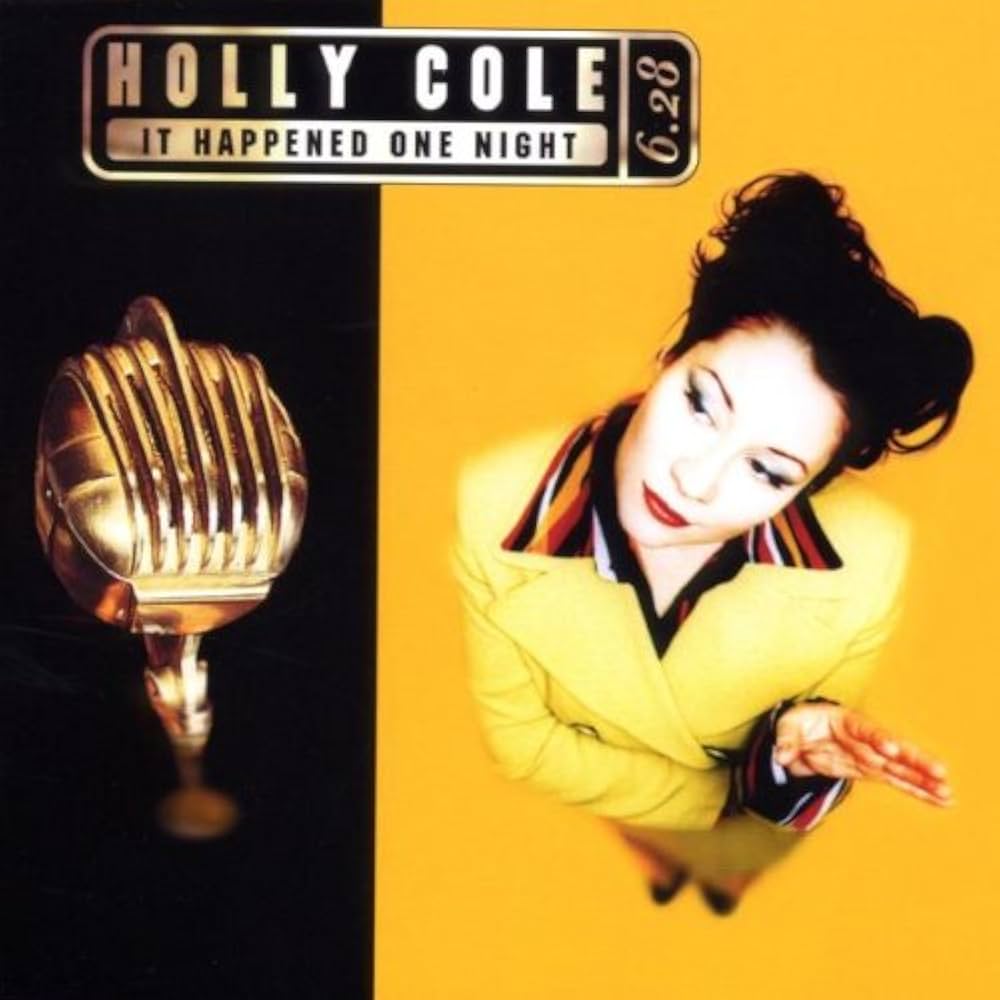
Holly Cole, Train Song (Live), “It Happened One Night”, 16-bit 44.1 kHz FLAC file streamed via ROON over Ethernet.
A great live recording that doesn’t get as much love as it should. The opening lumbering electric bassline of this Tom Waits cover song is deep and moody, coming through the Vantage 3 Live’s bass section with authority as it energized my room. Holly Cole’s voice was rendered with excellent body and accuracy, along with the associated reverb, accurately relaying the sense of space from the live recording venue. Even the whispered lyrics near the close of the song are clearly delineated by the Vantage 3 Live. The space appropriately sounds and feels bigger than the speaker’s placement might suggest.
You can tell that the percussionist on this track must be having fun! The sounds of the beans (or whatever you want to call them) that are inside the shakers/maracas that alternate in each of the channels are clearly relayed as distinct sounds versus a general noise when shaken. Details like an energetic cowbell, which is tapped with varying intensity through the second half of the song, are well back in space and have that distinctive metallic edge to its sound. There is also the sound of what is either a synthesizer or, more likely, an electronically processed electric guitar, creating warbling, atmospheric sounds which add additional depth and dimension to the sonic image. All these elements gelled together convincingly through these YG speakers, giving me a solid illusion of being at this concert.
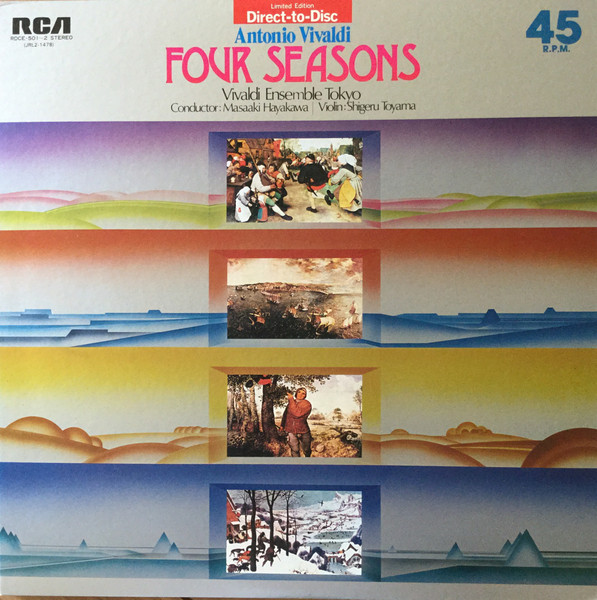
Antonio Vivaldi’s “The Four Seasons”, Vivaldi Ensemble Tokyo, Masaaki Hayakawa Conducting, Shigeru Toyama on violin, RCA, 45 RPM 2LP set, 1978.
From one of my local used record store outings and found buried in a corner of the Classical section, is this 2LP RCA Japan Direct-to-Disc recording of Vivaldi’s The Four Seasons. I figured it would be a fine way to get a measure of both the Vantage 3 Live’s built-in phono stage and how these advanced speakers would generally sound playing back a little vinyl. Setting the controller’s phono input to Moving Coil and the input impedance to 100 Ohms to suit my cartridge, the Vantage 3 Live rendered a beautifully big image of the 13-piece string ensemble. The violins and violas sounded beautifully airy and light without getting brittle in the highest part of their ranges. The cello and bass had an excellent sense of weight in them. String detail in all the instruments was nicely resolved, and the whole signal chain seemed to convincingly convey the sense of acoustics of the concert hall where the recording took place. Again, my mind slightly came into this review with a preconception that aluminum cabinets with aluminum drivers, analog-to-digital conversion, and class-D amplification could conspire to create a sound I might not care for. Nope. Not even in the slightest. If this setup could reproduce a dynamic vinyl recording of a full string ensemble and not make it sound harsh or edgy in the slightest, then that would be “mission accomplished.” And the Vantage 3 Live very much did just that!
There is a whole lot to like about the YG Acoustics Vantage 3 Live loudspeakers. The few criticisms I might have about them really have nothing to do with the sound or build quality but have more to do with some user experience details. For a little while, these were one of the few truly plug-and-play active loudspeakers of this caliber in their price range, but over the last year, Focal has released the less expensive Diva Utopias ($40K/pair) and, more recently, the larger Diva Mezza Utopias ($70K/pair) as competition. The question then becomes, “What does a buyer expect in this category for their $70,000-ish turnkey investment?” I would have wished that the controller on the Vantage 3 Live had a larger, more modern display that had more information about details like track information, bitrate, album artwork, etc. This sort of feature is expected in far less expensive streaming gear, so why not here? The sequence of key presses needed on the remote control to access a setting, change, and confirm said change can be a little tedious. There were a few occasions where a change I had thought I’d made in the tilt and bass boost settings did not actually take, and I had to repeat the sequence entirely while making sure I added an extra button press to confirm the change entered correctly. These are essentially niggles in a system as well-designed and executed as the Vantage 3 Live, with a sound quality that is in all respects outstanding. And yet, at this price point, these are the sorts of “finishing details” that matter more, at least they would to me.
Secrets Sponsor
Bench tests were performed with a Cross-Spectrum Labs calibrated UMIK-2 microphone connected to my computer workstation using Room EQ Wizard acoustic measurement software.
All near-field measurements were made with the microphone tip centered between the tweeter and midrange drivers (0-degrees) at a 1-meter distance from the speaker, with the test speaker positioned as far away from any walls as possible. The on-axis (0-degree) response in our nearfield measurements is made flat in the normalization process. As such, the resulting response variations are only due to the changes in either the horizontal or vertical axis. Nearfield measurements were made with the YG controller’s settings for Tilt and Bass Boost at their default 0 settings.
The In-room average response measurements are derived from an 18-point spatial average taken from around the listening position (11 ft away), with the microphone capsule placed at ear level. The overall in-room response was measured with a Bass Boost setting of +3 and a Tilt setting of +2.
Caveats: Unlike measurements taken outdoors or in an anechoic chamber that measures a speaker in isolation, in-room measurements give a sense of how a speaker behaves in the actual environment in which it’s used. Both types of measurements are valuable (make no mistake, a properly designed speaker in an anechoic environment will hold up much better in an average listening space), I just find in-room measurements interesting as they help shed light on what I am hearing and why. Note that no in-room measurement will ever match an anechoic measurement, and a measurement taken in my room won’t necessarily match a similarly done measurement taken in your room. But, after measuring dozens of speakers here, I’ve acquired a good understanding of how this space interacts with the speakers under test, and some general performance observations can always be drawn.
This in-room measurement of the YG Acoustics Vantage 3 Live tower speakers is an 18-point spatial average. A 9-point measurement was made for the right speaker and then repeated for the left speaker. Averaging both speakers is an approach others have been using and publishing. Using data from both speakers reduces the modal response of the room by averaging the differences in the response of the two speakers from room asymmetries. The technique cannot eliminate them, however, and so the response below 300 Hz remains room dominated.
David Rich notes:
It has been a long time since we have seen a speaker closely following a target curve. This is a DSP speaker, which no doubt helps. The fact that it is an adjustable speaker leaves ambiguity. It is unclear how closely the speaker could be matched to the target with further adjustments.
The red line on this graph is a linear fit to the in-room response. Comparing this slope to that of previous speakers reviewed in Carlo’s room reveals whether the speaker exhibits a characteristic of a studio monitor (less slope) or is more forgiving, with a faster slope. No correct answer exists, and what characteristic is more desirable is subject to personal preference. The slope of the line is -0.8dB per octave. As a comparison, both the YG Vantage 3 Live and the Perlisten S7t have a slope of -0.7dB per octave in Carlo’s room. Both these speakers exhibited a minimum amount of deviation from the linear target. The Vantage 3 Live uses DSP. The TAD CE-1TX had a slope of -0.9dB. The Sonus faber Olympica Nova 5 had a lumpy slope of -0.6dB per octave.
The slope of the line is the dominant subjective reaction to a speaker if the speaker closely corresponds to the line. The peaks and dips around the line can be heard as a defect if the speaker is compared to a more linear speaker. Hearing these characteristics is best done under blind conditions.
YG gives the option to change the slope through settings found in the preamp/controller unit. Carlo did produce a graph (below) showing the difference between the Vantage 3 Live’s “default” in-room response (0 – Bass Boost, 0 – Tilt) against his preferred Bass Boost and Tilt settings
Note the reduced energy above 1 kHz. That is why we are showing this curve. The tilt option improves it.
The bass lift is purely a matter of user preference.
This is a plot of the NRC listening window for the YG Acoustics Vantage 3 Live, scaled from 300 Hz on up, which is averaged from the following measurements: 0-degree on- axis, +/-15-degrees vertical, and +/-15-degrees horizontal. This is the portion of the frequency range that is dominated by the speaker (response below 300 Hz tends to be dominated by the room and can vary greatly).
David Rich notes:
As expected, a DSP speaker should produce a flat response if equalization is being applied to compensate for driver imperfections. As we saw above, this curve can be made to look flatter with the tilt control. The midrange response here is already very flat.
This is a plot of the CEA-2034A listening window for the YG Acoustics Vantage 3 Live, scaled from 300 Hz on up, which is averaged from the following measurements: 0- degree on-axis, +/-10-degrees vertical, +/-10-degrees, and +/- 20-degrees horizontal. This is the portion of the frequency range that is dominated by the speaker (response below 300 Hz tends to be dominated by the room and can vary greatly).
David Rich notes:
The CEA2034A curves are almost identical to the NRC curves, indicating the close- angle radiation patterns are well-matched.
Above are the normalized horizontal radiation curves of the YG Acoustics Vantage 3 Live from 0 to 90 degrees, scaled from 300 Hz on up, measured in-room in the near field. In a normalized curve, the on-axis curve is changed to be a flat line, so only the differences in response caused by the changes in angles are seen.
David Rich notes:
YG has been using waveguides on the tweeter for a long time. From this curve, it might lead one to assume that the crossover is at 3 kHz with a small snap back at the smaller radiation angles. 3 kHz appears to correspond to the level rise in the NRC and CEA2034 radiation patterns. Yet as we will see below in the vertical response, the actual crossover frequency appears to be closer to 2 kHz with an almost perfect match at all angles.
Similar to the 3 kHz non-monotonic response change at different angles, a similar change occurs at 6 kHz. YG claims that the 6 kHz change only shows up in near-field measurements, because the speaker wasn’t designed for near-field driver lobe coincidence. This change would not show up when measured in an anechoic chamber.
Moving to the normalized vertical radiation pattern for positive angles. We see the plots of 0 to +20 degrees, scaled from 300 Hz on up, measured in-room in the near field.
David Rich notes:
This curve clearly shows the crossover of the tweeter at 1.8 kHz to 2 kHz area. The interference between drivers, resulting from the physical displacement of the drivers, occurs over a broader range than expected for a 4th-order LR crossover.
Here we have the normalized vertical radiation pattern for negative angles. We see the plots for 0 to -20 degrees, scaled from 300 Hz on up, measured in-room in the near field.
David Rich notes:
The change in response with increasing angle is remarkably small in this curve, in contrast to the previous curve.
I note that this is an in-room measurement with the speaker on the floor, given its weight. The floor reflections are at a high amplitude given the distance of the microphone to the floor.
If you are hellbent on getting a high-end luxury all-in-one speaker system, the YG Acoustics Vantage 3 Live deserves your undivided attention.
- Meticulous build quality and fit/finish of the speakers.
- Outstanding sound quality, with the ability to tailor to the room.
- Excellent dynamics and transparency. It will play loudly without strain.
- Huge sound from a modestly sized tower speaker package.
- Pretty much a plug-and-play system with room to add/expand.
- Bigger and more comprehensive display on the controller unit.
- XLR inputs.
The YG Acoustics Vantage 3 Live is a compelling proposition for the well-heeled audio lover. You get an extremely high-end, self-contained system, complete with source, that rewards you with a superb level of sound quality. It also provides a genuinely useful measure of adjustment to suit that sound to your taste and room. The partnership with BelCanto to develop the control and amplification components of this system is exceedingly successful, and throws a wrench into that old argument of the amplifiers and the general guts inside active loudspeakers not being “good enough,” or “not what I would choose.” Baloney! The entire system, from the edge of the volume knob to the tips of the speaker cones, drips with all the technical sophistication, build quality, unique aesthetic, and, ultimately, sound quality that committed audio enthusiasts with deep pockets would crave. Vinyl lovers are not forgotten in this brave new world either, as the integrated MM and MC phono stage works very well and is satisfying to listen to.
It’s also an easy-to-live-with system that can confidently and cleanly fill a large room with sound from a minimally intrusive set of towers. They will legit reach down to the mid-20 Hz region, so you don’t need subwoofers, unless you really want to feel those 16 Hz organ notes. And in case, for whatever earthly reason, you don’t think that the Vantage 3 Live is big or expensive enough, YG Acoustics will only be too happy to steer you to their Live (active) versions of the Sonja 3 and XX systems, which have the same electronics and amplifier architecture (just more of it). Are there a few usability additions and refinements that I would like to see implemented? Sure, there are, especially when you are dealing in the realm of high-end luxury audio. But the Vantage 3 Live, as it currently stands, is a technical and sonic winner in my books. You owe yourself a listen to these! Even if you can’t afford them. Just to hear and experience what is possible.
High-end active loudspeakers are rapidly coming of age, and any limitations have more to do with the antiquated mindset of some listeners rather than of the products themselves. I expect that, soon, this too shall pass.
The author would like to thank David A. Rich for his invaluable assistance in this review.


